
- school Campus Bookshelves
- menu_book Bookshelves
- perm_media Learning Objects
- login Login
- how_to_reg Request Instructor Account
- hub Instructor Commons
- Download Page (PDF)
- Download Full Book (PDF)
- Periodic Table
- Physics Constants
- Scientific Calculator
- Reference & Cite
- Tools expand_more
- Readability
selected template will load here
This action is not available.


23.2: Electromagnetic Waves and their Properties
- Last updated
- Save as PDF
- Page ID 15712
learning objectives
- Explain the meaning and importance of Maxwell’s equations
Maxwell’s Equations
Maxwell’s equations are a set of four partial differential equations that, along with the Lorentz force law, form the foundation of classical electrodynamics, classical optics, and electric circuits.
Named after esteemed physicist James Clerk Maxwell, the equations describe the creation and propagation of electric and magnetic fields. Fundamentally, they describe how electric charges and currents create electric and magnetic fields, and how they affect each other.
Maxwell’s equations can be divided into two major subsets. The first two, Gauss’s law and Gauss’s law for magnetism, describe how fields emanate from charges and magnets respectively. The other two, Faraday’s law and Ampere’s law with Maxwell’s correction, describe how induced electric and magnetic fields circulate around their respective sources.
Each of Maxwell’s equations can be looked at from the “microscopic” perspective, which deals with total charge and total current, and the “macroscopic” set, which defines two new auxiliary fields that allow one to perform calculations without knowing microscopic data like atomic-level charges.
Gauss’s Law
Gauss’s law relates an electric field to the charge(s) that create(s) it. The field (E) points towards negative charges and away from positive charges, and from the microscopic perspective, is related to charge density (ρ) and vaccuum permittivity (ε 0 , or permittivity of free space) as:
\[\nabla \cdot \mathbf { E } = \dfrac { \rho } { \epsilon _ { 0 } }\]
Gauss’s Law basically says that a net amount of charge contained within a region of space will generate an electric field that emanates through the surface that surrounds that region.
Example of Gauss’s Law : A positive charge contained within a region of space creates an electric field that emanates from the surface of that region.
Gauss’s Law for Magnetism
Gauss’s law for magnetism states that there are no “magnetic charges (or monopoles)” analogous to electric charges, and that magnetic fields are instead generated by magnetic dipoles . Such dipoles can be represented as loops of current, but in many ways are similar in appearance to positive and negative “magnetic charges” that are inseparable and thus have no formal net “magnetic charge.”
Magnetic field lines form loops such that all field lines that go into an object leave it at some point. Thus, the total magnetic flux through a surface surrounding a magnetic dipole is always zero.
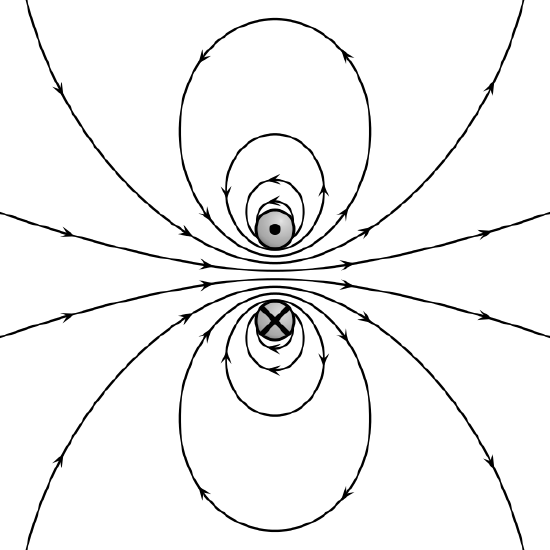
Field lines caused by a magnetic dipole : The field lines created by this magnetic dipole either form loops or extend infinitely.
The differential form of Gauss’s law for magnetic for magnetism is
\[\nabla \cdot \mathbf { B } = \mathbf { 0 }\]
Faraday’s Law
Faraday’s law describes how a time-varying magnetic field (or flux) induces an electric field. The principle behind this phenomenon is used in many electric generators. Both macroscopic and microscopic differential equations are the same, relating electric field (E) to the time-partial derivative of magnetic field (B):
\[\nabla \times \mathbf { E } = - \frac { \partial \mathbf { B } } { \partial \mathbf { t } }\]
Ampere’s Circuital Law (with Maxwell’s correction)
Ampere’s law originally stated that magnetic field could be created by electrical current. Maxwell added a second source of magnetic fields in his correction: a changing electric field (or flux), which would induce a magnetic field even in the absence of an electrical current. He named the changing electric field “displacement current.”
Maxwell’s correction shows that self-sustaining electromagnetic waves (light) can travel through empty space even in the absence of moving charges or currents, with the electric field component and magnetic field component each continually changing and each perpetuating the other.
Electromagnetic Waves : Electric (red) and magnetic (blue) waves propagate in phase sinusoidally, and perpendicularly to one another.
The microscopic approach to the Maxwell-corrected Ampere’s law relates magnetic field (B) to current density (J, or current per unit cross sectional area) and the time-partial derivative of electric field (E):
\[\nabla \times \mathbf { B } = \mu _ { 0 } \mathbf { J } + \mu _ { 0 } \epsilon _ { 0 } \frac { \partial \mathbf { E } } { \partial t }\]
The Production of Electromagnetic Waves
Electromagnetic waves are the combination of electric and magnetic field waves produced by moving charges.
- Explain the self-perpetuating behavior of an electromagnetic wave
Electromagnetic waves
Electromagnetic radiation, is a form of energy emitted by moving charged particles. As it travels through space it behaves like a wave, and has an oscillating electric field component and an oscillating magnetic field. These waves oscillate perpendicularly to and in phase with one another.

Electromagnetic Wave : Electromagnetic waves are a self-propagating transverse wave of oscillating electric and magnetic fields. The direction of the electric field is indicated in blue, the magnetic field in red, and the wave propagates in the positive x-direction. Notice that the electric and magnetic field waves are in phase.
The creation of all electromagnetic waves begins with a charged particle. This charged particle creates an electric field (which can exert a force on other nearby charged particles). When it accelerates as part of an oscillatory motion, the charged particle creates ripples, or oscillations, in its electric field, and also produces a magnetic field (as predicted by Maxwell’s equations).
Once in motion, the electric and magnetic fields created by a charged particle are self-perpetuating—time-dependent changes in one field (electric or magnetic) produce the other. This means that an electric field that oscillates as a function of time will produce a magnetic field, and a magnetic field that changes as a function of time will produce an electric field. Both electric and magnetic fields in an electromagnetic wave will fluctuate in time, one causing the other to change.
Electromagnetic waves are ubiquitous in nature (i.e., light) and used in modern technology—AM and FM radio, cordless and cellular phones, garage door openers, wireless networks, radar, microwave ovens, etc. These and many more such devices use electromagnetic waves to transmit data and signals.
All the above sources of electromagnetic waves use the simple principle of moving charge, which can be easily modeled. Placing a coin in contact with both terminals of a 9-volt battery produces electromagnetic waves that can be detected by bringing the antenna of a radio (tuned to a static-producing station) within a few inches of the point of contact.
Energy and Momentum
Electromagnetic waves have energy and momentum that are both associated with their wavelength and frequency.
- Relate energy of an electromagnetic wave with the frequency and wavelength
Electromagnetic radiation can essentially be described as photon streams. These photons are strictly defined as massless, but have both energy and surprisingly, given their lack of mass, momentum, which can be calculated from their wave properties.
Waves were poorly understood until the 1900s, when Max Planck and Albert Einstein developed modern corrections to classical theory.
Planck theorized that “black bodies” (thermal radiators) and other forms of electromagnetic radiation existed not as spectra, but in discrete, “quantized” form. In other words, there were only certain energies an electromagnetic wave could have. In his work he developed what is now known as “Planck’s constant,” which is approximately equal to 6.626×10 -34 J·s.
The energy (E) of a photon can be related to its frequency (f) by Planck’s constant (h):
\[\mathrm { E } = \mathrm { hf } = \frac { \mathrm { hc } } { \lambda }\]
The ratio of speed of light (c) to wavelength (λ) can be substituted in place of f to give the same equation to energy in different terms. Note that energy cannot take any value: it can only exist in increments of frequency times Planck’s constant (or Planck’s constant times c divided by wavelength). Energy of a wave is therefore “quantized. ”
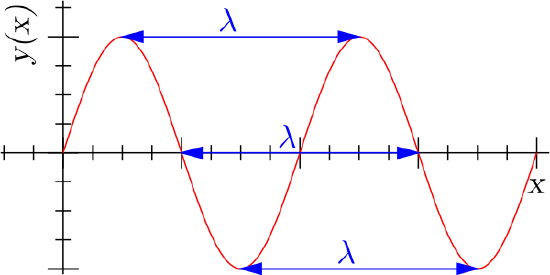
Wavelength : Wavelength of the sinusoidal function is represented by λ.
Momentum is classically defined as the product of mass and velocity and thus would intuitively seem irrelevant to a discussion of electromagnetic radiation, which is both massless and composed of waves.
However, Einstein proved that light can act as particles in some circumstances, and that a wave-particle duality exists. And, given that he related energy and mass (E=mc 2 ), it becomes more conceivable that a wave (which has an energy value) not only has an equation to mass but a momentum as well.
And indeed, Einstein proved that the momentum (p) of a photon is the ratio of its energy to the speed of light.
\[\mathrm { p } = \dfrac { \mathrm { E } } { \mathrm { c } } = \dfrac { \mathrm { hf } } { \mathrm { c } } = \dfrac { \mathrm { h } } { \lambda }\]
Substituting E with hc/λ cancels the c terms, making momentum also equal to the simple ratio of Planck’s constant to wavelength.
The Speed of Light
The speed of light in a vacuum is one of the most fundamental constant in physics, playing a pivotal role in modern physics.
- Relate speed of light with the index of refraction of the medium
The speed of light is generally a point of comparison to express that something is fast. shows a scale representation of the time it takes a beam of light to reach the moon from Earth. But what exactly is the speed of light?
Light Going from Earth to the Moon : A beam of light is depicted travelling between the Earth and the Moon in the time it takes a light pulse to move between them: 1.255 seconds at their mean orbital (surface-to-surface) distance. The relative sizes and separation of the Earth–Moon system are shown to scale.
It is just that: the speed of a photon or light particle. The speed of light in a vacuum (commonly written as c) is 299,792,458 meters per second. This is a universal physical constant used in many areas of physics. For example, you might be familiar with the equation:
\[\mathrm { E } = \mathrm { mc } ^ { 2 }\]
where E = Energy and m = mass. This is known as the mass-energy equivalence, and it uses the speed of light to interrelate space and time. This not only explains the energy a body of mass contains, but also explains the hindrance mass has on speed.
There are many uses for the speed of light in a vacuum, such as in special relativity, which says that c is the natural speed limit and nothing can move faster than it. However, we know from our understanding of physics (and previous atoms) that the speed at which something travels also depends on the medium through which it is traveling. The speed at which light propagates through transparent materials (air, glass, etc.,) is dependent on the refractive index of that material, n:
\[\mathrm { v } = \dfrac { \mathrm { c } } { \mathrm { n } }\]
where v = actual velocity of light moving through the medium, c = speed of light in a vacuum, and n = refractive index of medium. The refractive index of air is about 1.0003, and from this equation we can find that the speed of visible light in air is about 90 km/s slower than c.
As mentioned earlier, the speed of light (usually of light in a vacuum) is used in many areas of physics. Below is an example of an application of the constant c.
The Lorentz Factor
Fast-moving objects exhibit some properties that are counterintuitive from the perspective of classical mechanics. For example, length contracts and time dilates (runs slower) for objects in motion. The effects are typically minute, but are noticeable at sufficiently high speeds. The Lorentz factor (γ) is the factor by which length shortens and time dilates as a function of velocity (v):
\[\gamma = \left( 1 - \mathrm{ v } ^ { 2 } / \mathrm { c } ^ { 2 } \right) ^ { - 1 / 2 } \gamma = \left( 1 - \mathrm { v } ^ { 2 } / \mathrm { c } ^ { 2 } \right) ^ { - 1 / 2 } \gamma = \left( 1 - \mathrm { v } ^ { 2 } / \mathrm { c } ^ { 2 } \right) ^ { - 1 / 2 }\]
At low velocities, the quotient of v 2 /c 2 is sufficiently close to 0 such that γ is approximately 1. However, as velocity approaches c, γ increases rapidly towards infinity.
The Doppler Effect
The Doppler Effect is the change in a wave’s perceived frequency that results from the source’s motion, the observer, and the medium.
- Give examples of daily observations of the Doppler effect
The Doppler effect is a periodic event’s change in frequency for an observer in motion relative to the event’s source. Typically, this periodic event is a wave.
Most people have experienced the Doppler effect in action. Consider an emergency vehicle in motion, sounding its siren. As it approaches an observer, the pitch of the sound (its frequency) sounds higher than it actually is. When the vehicle reaches the observer, the pitch is perceived as it actually is. When the vehicle continues away from the observer, the pitch is perceived as lower than it actually is. From the perspective of an observer inside the vehicle, the pitch of the siren is constant.
The Doppler Effect and Sirens : Waves emitted by a siren in a moving vehicle
The difference in the perceived pitch depending on observer location can be explained by the fact that the siren’s position changes as it emits waves. A wave of sound is emitted by a moving vehicle every millisecond. The vehicle ‘chases’ each wave in one direction. By the time the next wave is emitted, it is closer (relative to an onlooker ahead of the vehicle) to the previous wave than the wave’s frequency would suggest. Relative to an onlooker behind the vehicle, the second wave is further from the first wave than one would expect, which suggests a lower frequency.
The Doppler effect can be caused by any kind of motion. In the example above, the siren moved relative to a stationary observer. If the observer moves relative to the stationary siren, the observer will notice the Doppler effect on the pitch of the siren. Finally, if the medium through which the waves propagate moves, the Doppler effect will be noticed even for a stationary observer. An example of this phenomenon is wind.
Quantitatively, the Doppler effect can be characterized by relating the frequency perceived (f) to the velocity of waves in the medium (c), the velocity of the receiver relative to the medium (v r ), the velocity of the source relative to the medium (v s ), and the actual emitted frequency (f 0 ):
\[\mathrm { f } = \left( \dfrac { \mathrm { c } + \mathrm { v } _ { \mathrm { r } } } { \mathrm { c } + \mathrm { v } _ { \mathrm { s } } } \right) \mathrm { f } _ { 0 }\]
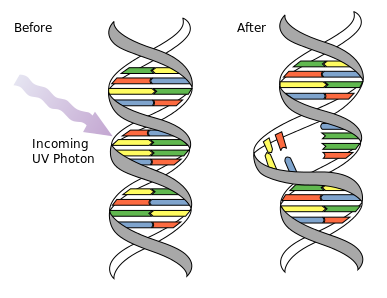
The Doppler Effect : Wavelength change due to the motion of source
Momentum Transfer and Radiation Pressure Atom
Radiation pressure is the pressure exerted upon any surface exposed to electromagnetic (EM) radiation.
- Explain formation of radiation pressure
Radiation pressure is the pressure exerted upon any surface exposed to electromagnetic (EM) radiation. EM radiation (or photon, which is a quantum of light) carries momentum; this momentum is transferred to an object when the radiation is absorbed or reflected. Perhaps one of the most well know examples of the radiation pressure would be comet tails. Haley’s comet is shown in.
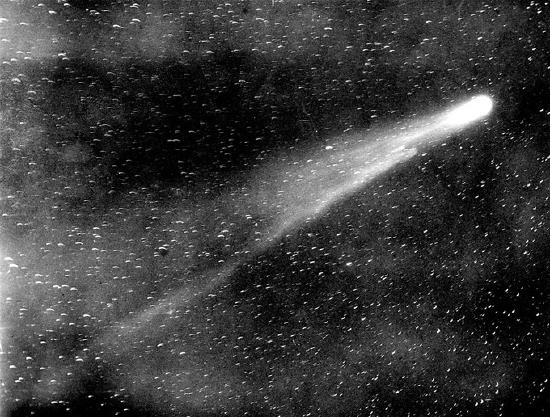
Halley’s Comet : As a comet approaches the inner Solar System, solar radiation causes the volatile materials within the comet to vaporize and stream out of the nucleus. The streams of dust and gas thus released form an atmosphere around the comet (called the coma), and the force exerted on the coma by the Sun’s radiation pressure and solar wind cause the formation of an enormous tail that points away from the Sun.
Although radiation pressure can be understood using classical electrodynamics, here we will examine the quantum mechanical argument. From the perspective of quantum theory, light is made of photons: particles with zero mass but which carry energy and – importantly in this argument – momentum. According to special relativity, because photons are devoid of mass, their energy (E) and momentum (p) are related by E=pc.
Now consider a beam of light perpendicularly incident on a surface, and let us assume the beam of light is totally absorbed. The momentum the photons carry is a conserved quantity (i.e., it cannot be destroyed) so it must be transferred to the surface; thus the absorption of the light beam causes the surface to gain momentum. Newton’s Second Law tells us that force equals rate of change of momentum; thus during each second, the surface experiences a force (or pressure, as pressure is force per unit area) due to the momentum the photons transfer to it.
This gives us: pressure = momentum transferred per second per unit area = energy deposited per second per unit area / c = I/c, (where I is the intensity of the beam of light).
Laser Cooling
There are many variations of laser cooling, but they all use radiation pressure to remove energy from atomic gases (and therefore cool the sample). In laser cooling (sometimes called Doppler cooling), the frequency of light is tuned slightly below an electronic transition in the atom. Because light is detuned to the “red” (i.e., at lower frequency) of the transition, the atoms will absorb more photons if they move towards the light source, due to the Doppler effect. Thus if one applies light from two opposite directions, the atoms will always scatter more photons from the laser beam pointing opposite to their direction of motion (typical setups applies three opposing pairs of laser beams as in ).
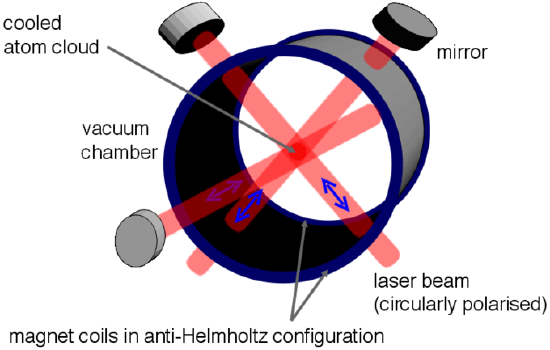
The Magneto Optical Trap : Experimental setup of Magneto Optical Trap (MOT), which uses radiation pressure to cool atomic species. Atoms are slowed down by absorbing (and emitting) photons.
In each scattering event, the atom loses a momentum equal to the momentum of the photon. If the atom (which is now in the excited state) then emits a photon spontaneously, it will be kicked by the same amount of momentum, only in a random direction. Since the initial momentum loss was opposite to the direction of motion (while the subsequent momentum gain was in a random direction), the overall result of the absorption and emission process is to reduce the speed of the atom. If the absorption and emission are repeated many times, the average speed (and therefore the kinetic energy ) of the atom will be reduced. Since the temperature of a group of atoms is a measure of the average random internal kinetic energy, this is equivalent to cooling the atoms. Simple laser cooling setups can produce a cold sample of atomic gases at around 1mK (=10 -3 K) starting from a room temperature gas.
- Maxwell’s four equations describe how electric charges and currents create electric and magnetic fields, and how they affect each other.
- Gauss’s law relates an electric field to the charge(s) that create(s) it.
- Gauss’s law for magnetism states that there are no “magnetic charges” analogous to electric charges, and that magnetic fields are instead generated by magnetic dipoles.
- Faraday’s law describes how a time-varying magnetic field (or flux ) induces an electric field. The principle behind this phenomenon is used in many electric generators.
- Ampere ‘s law originally stated that a magnetic field is created by an electrical current. Maxwell added that a changing electric flux can also generate a magnetic field.
- Electromagnetic waves consist of both electric and magnetic field waves. These waves oscillate in perpendicular planes with respect to each other, and are in phase.
- The creation of all electromagnetic waves begins with an oscillating charged particle, which creates oscillating electric and magnetic fields.
- Once in motion, the electric and magnetic fields that a charged particle creates are self-perpetuating: time-dependent changes in one field (electric or magnetic) produce the other.
- Max Planck proved that energy of a photon (a stream of which is an electromagnetic wave ) is quantized and can exist in multiples of “Planck’s constant” (denoted as h, approximately equal to 6.626×10 -34 J·s).
- \(\mathrm { E } = \mathrm { hf } = \frac { \mathrm { hc } } { \lambda } \)describes the energy (E) of a photon as a function of frequency (f), or wavelength (λ).
- \(\mathrm { p } = \frac { \mathrm { E } } { \mathrm { c } } = \frac { \mathrm { hf } } { \mathrm { c } } = \frac { \mathrm { h } } { \lambda }\) describes the momentum (p) of a photon as a function of its energy, frequency, or wavelength.
- The maximum possible value for the speed of light is that of light in a vacuum, and this speed is used for a constant in many area of physics.
- c is the symbol used to represent the speed of light in a vacuum, and its value is 299,792,458 meters per second.
- When light travels through medium, its speed is hindered by the index of refraction of that medium. Its actual speed can be found with: \(v=\frac{c}{n}\).
- The Doppler effect is very commonly observed in action.
- The Doppler effect can be observed in the apparent change in pitch of a siren on an emergency vehicle, according to a stationary observer.
- The observer will notice the Doppler effect on the pitch of the stationary siren when moving relative to its pitch, or if the medium moves when the observer is stationary.
- Photons carry momentum (p = E/c). When photons are absorbed or reflected on a surface, the surface receives momentum kicks. This momentum transfer leads to radiation pressure.
- Electromagnetic radiation applies radiation pressure equal to the Intensity (of light beam) divided by c (speed of light).
- Laser cooling uses radiation pressure to remove energy from atomic gases. The technique can produce cold samples of gases at 1mK or so.
- differential equation : An equation involving the derivatives of a function.
- flux : A quantitative description of the transfer of a given vector quantity through a surface. In this context, we refer to the electric flux and magnetic flux.
- electromagnetic wave : A wave of oscillating electric and magnetic fields.
- phase : Waves are said to be “in phase” when they begin at the same part (e.g., crest) of their respective cycles.
- photon : The quantum of light and other electromagnetic energy, regarded as a discrete particle having zero rest mass, no electric charge, and an indefinitely long lifetime.
- wavelength : The length of a single cycle of a wave, as measured by the distance between one peak or trough of a wave and the next; it is often designated in physics as λ, and corresponds to the velocity of the wave divided by its frequency.
- frequency : The quotient of the number of times n a periodic phenomenon occurs over the time t in which it occurs: f = n / t.
- special relativity : A theory that (neglecting the effects of gravity) reconciles the principle of relativity with the observation that the speed of light is constant in all frames of reference.
- refractive index : The ratio of the speed of light in air or vacuum to that in another medium.
- doppler effect : Apparent change in frequency of a wave when the observer and the source of the wave move relative to each other.
- classical electrodynamics : A branch of theoretical physics that studies consequences of the electromagnetic forces between electric charges and currents.
LICENSES AND ATTRIBUTIONS
CC LICENSED CONTENT, SHARED PREVIOUSLY
- Curation and Revision. Provided by : Boundless.com. License : CC BY-SA: Attribution-ShareAlike
CC LICENSED CONTENT, SPECIFIC ATTRIBUTION
- flux. Provided by : Wiktionary. Located at : http://en.wiktionary.org/wiki/flux . License : CC BY-SA: Attribution-ShareAlike
- differential equation. Provided by : Wiktionary. Located at : http://en.wiktionary.org/wiki/differential_equation . License : CC BY-SA: Attribution-ShareAlike
- Maxwell's equations. Provided by : Wikipedia. Located at : http://en.Wikipedia.org/wiki/Maxwell's_equations . License : CC BY-SA: Attribution-ShareAlike
- Electromagneticwave3D. Provided by : Wikipedia. Located at : en.Wikipedia.org/wiki/File:Electromagneticwave3D.gif . License : CC BY-SA: Attribution-ShareAlike
- GaussLaw1. Provided by : Wikimedia. Located at : http://upload.wikimedia.org/Wikipedia/commons/5/57/GaussLaw1.svg . License : CC BY-SA: Attribution-ShareAlike
- VFPt dipole magnetic1. Provided by : Wikipedia. Located at : en.Wikipedia.org/wiki/File:VFPt_dipole_magnetic1.svg . License : CC BY-SA: Attribution-ShareAlike
- Electromagnetic radiation. Provided by : Wikipedia. Located at : en.Wikipedia.org/wiki/Electromagnetic_radiation . License : CC BY-SA: Attribution-ShareAlike
- electromagnetic wave. Provided by : Wikipedia. Located at : en.Wikipedia.org/wiki/electromagnetic%20wave . License : CC BY-SA: Attribution-ShareAlike
- phase. Provided by : Wiktionary. Located at : en.wiktionary.org/wiki/phase . License : CC BY-SA: Attribution-ShareAlike
- Onde electromagnetique. Provided by : Wikipedia. Located at : en.Wikipedia.org/wiki/File:Onde_electromagnetique.svg . License : CC BY-SA: Attribution-ShareAlike
- wavelength. Provided by : Wiktionary. Located at : en.wiktionary.org/wiki/wavelength . License : CC BY-SA: Attribution-ShareAlike
- frequency. Provided by : Wiktionary. Located at : en.wiktionary.org/wiki/frequency . License : CC BY-SA: Attribution-ShareAlike
- photon. Provided by : Wikipedia. Located at : en.Wikipedia.org/wiki/photon . License : CC BY-SA: Attribution-ShareAlike
- Sine wavelength. Provided by : Wikipedia. Located at : en.Wikipedia.org/wiki/File:Sine_wavelength.svg . License : CC BY-SA: Attribution-ShareAlike
- refractive index. Provided by : Wiktionary. Located at : en.wiktionary.org/wiki/refractive_index . License : CC BY-SA: Attribution-ShareAlike
- Speed of light. Provided by : Wikipedia. Located at : en.Wikipedia.org/wiki/Speed_of_light . License : CC BY-SA: Attribution-ShareAlike
- special relativity. Provided by : Wiktionary. Located at : en.wiktionary.org/wiki/special_relativity . License : CC BY-SA: Attribution-ShareAlike
- Speed of light. Provided by : Wikipedia. Located at : en.Wikipedia.org/wiki/Speed_of_light . License : Public Domain: No Known Copyright
- Doppler effect. Provided by : Wikipedia. Located at : en.Wikipedia.org/wiki/Doppler_effect . License : CC BY-SA: Attribution-ShareAlike
- Boundless. Provided by : Boundless Learning. Located at : www.boundless.com//physics/definition/doppler-effect--2 . License : CC BY-SA: Attribution-ShareAlike
- Dopplerfrequenz. Provided by : Wikipedia. Located at : en.Wikipedia.org/wiki/File:Dopplerfrequenz.gif . License : CC BY-SA: Attribution-ShareAlike
- Doppler effect diagrammatic. Provided by : Wikipedia. Located at : en.Wikipedia.org/wiki/File:Doppler_effect_diagrammatic.png . License : CC BY-SA: Attribution-ShareAlike
- Radiation pressure. Provided by : Wikipedia. Located at : en.Wikipedia.org/wiki/Radiation_pressure . License : CC BY-SA: Attribution-ShareAlike
- classical electrodynamics. Provided by : Wikipedia. Located at : en.Wikipedia.org/wiki/classical%20electrodynamics . License : CC BY-SA: Attribution-ShareAlike
- Electromagneticwave3D. Provided by : Wikipedia. Located at : http://en.Wikipedia.org/wiki/File:Electromagneticwave3D.gif . License : CC BY-SA: Attribution-ShareAlike
- VFPt dipole magnetic1. Provided by : Wikipedia. Located at : http://en.Wikipedia.org/wiki/File:VFPt_dipole_magnetic1.svg . License : CC BY-SA: Attribution-ShareAlike
- Comet. Provided by : Wikipedia. Located at : en.Wikipedia.org/wiki/Comet . License : CC BY: Attribution
- Magneto-optical trap. Provided by : Wikipedia. Located at : en.Wikipedia.org/wiki/Magneto-optical_trap . License : CC BY: Attribution

Anatomy of an Electromagnetic Wave
Energy, a measure of the ability to do work, comes in many forms and can transform from one type to another. Examples of stored or potential energy include batteries and water behind a dam. Objects in motion are examples of kinetic energy. Charged particles—such as electrons and protons—create electromagnetic fields when they move, and these fields transport the type of energy we call electromagnetic radiation, or light.

What are Electromagnetic and Mechanical waves?
Mechanical waves and electromagnetic waves are two important ways that energy is transported in the world around us. Waves in water and sound waves in air are two examples of mechanical waves. Mechanical waves are caused by a disturbance or vibration in matter, whether solid, gas, liquid, or plasma. Matter that waves are traveling through is called a medium. Water waves are formed by vibrations in a liquid and sound waves are formed by vibrations in a gas (air). These mechanical waves travel through a medium by causing the molecules to bump into each other, like falling dominoes transferring energy from one to the next. Sound waves cannot travel in the vacuum of space because there is no medium to transmit these mechanical waves.

ELECTROMAGNETIC WAVES
Electricity can be static, like the energy that can make your hair stand on end. Magnetism can also be static, as it is in a refrigerator magnet. A changing magnetic field will induce a changing electric field and vice-versa—the two are linked. These changing fields form electromagnetic waves. Electromagnetic waves differ from mechanical waves in that they do not require a medium to propagate. This means that electromagnetic waves can travel not only through air and solid materials, but also through the vacuum of space.
In the 1860's and 1870's, a Scottish scientist named James Clerk Maxwell developed a scientific theory to explain electromagnetic waves. He noticed that electrical fields and magnetic fields can couple together to form electromagnetic waves. He summarized this relationship between electricity and magnetism into what are now referred to as "Maxwell's Equations."
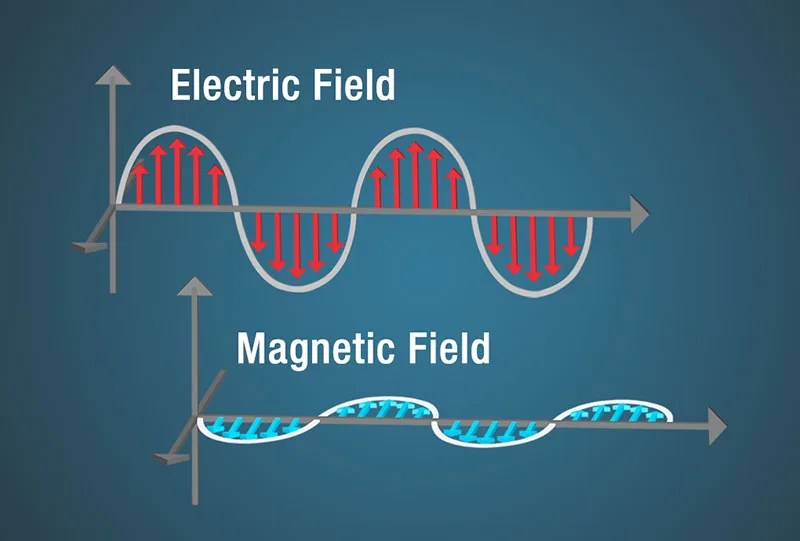
Heinrich Hertz, a German physicist, applied Maxwell's theories to the production and reception of radio waves. The unit of frequency of a radio wave -- one cycle per second -- is named the hertz, in honor of Heinrich Hertz.
His experiment with radio waves solved two problems. First, he had demonstrated in the concrete, what Maxwell had only theorized — that the velocity of radio waves was equal to the velocity of light! This proved that radio waves were a form of light! Second, Hertz found out how to make the electric and magnetic fields detach themselves from wires and go free as Maxwell's waves — electromagnetic waves.
WAVES OR PARTICLES? YES!
Light is made of discrete packets of energy called photons. Photons carry momentum, have no mass, and travel at the speed of light. All light has both particle-like and wave-like properties. How an instrument is designed to sense the light influences which of these properties are observed. An instrument that diffracts light into a spectrum for analysis is an example of observing the wave-like property of light. The particle-like nature of light is observed by detectors used in digital cameras—individual photons liberate electrons that are used for the detection and storage of the image data.
POLARIZATION
One of the physical properties of light is that it can be polarized. Polarization is a measurement of the electromagnetic field's alignment. In the figure above, the electric field (in red) is vertically polarized. Think of a throwing a Frisbee at a picket fence. In one orientation it will pass through, in another it will be rejected. This is similar to how sunglasses are able to eliminate glare by absorbing the polarized portion of the light.
DESCRIBING ELECTROMAGNETIC ENERGY
The terms light, electromagnetic waves, and radiation all refer to the same physical phenomenon: electromagnetic energy. This energy can be described by frequency, wavelength, or energy. All three are related mathematically such that if you know one, you can calculate the other two. Radio and microwaves are usually described in terms of frequency (Hertz), infrared and visible light in terms of wavelength (meters), and x-rays and gamma rays in terms of energy (electron volts). This is a scientific convention that allows the convenient use of units that have numbers that are neither too large nor too small.
The number of crests that pass a given point within one second is described as the frequency of the wave. One wave—or cycle—per second is called a Hertz (Hz), after Heinrich Hertz who established the existence of radio waves. A wave with two cycles that pass a point in one second has a frequency of 2 Hz.
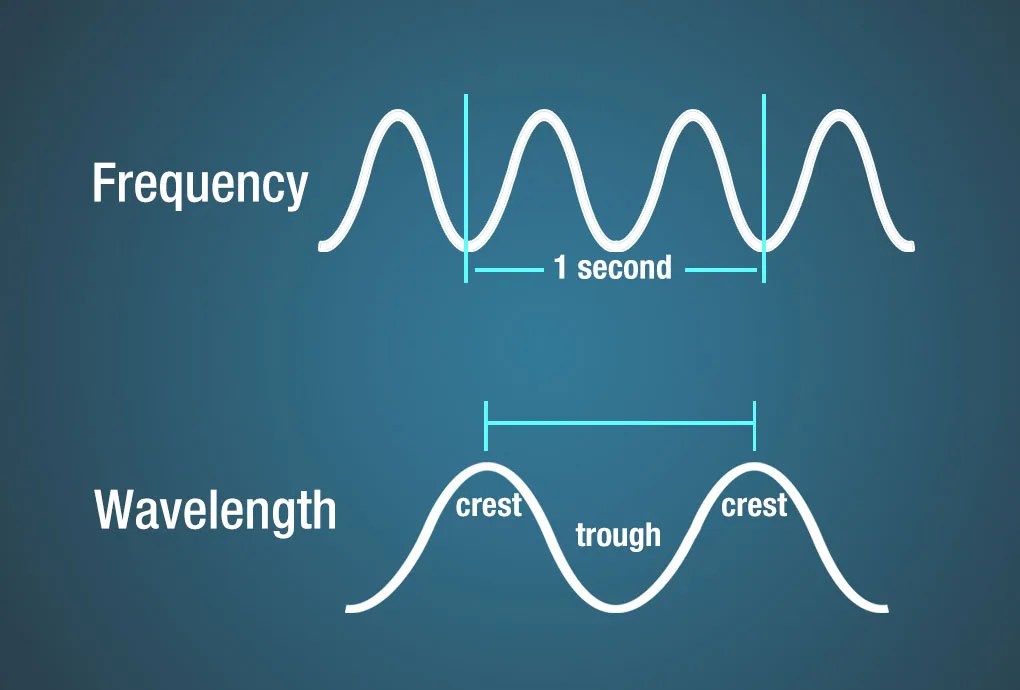
Electromagnetic waves have crests and troughs similar to those of ocean waves. The distance between crests is the wavelength. The shortest wavelengths are just fractions of the size of an atom, while the longest wavelengths scientists currently study can be larger than the diameter of our planet!
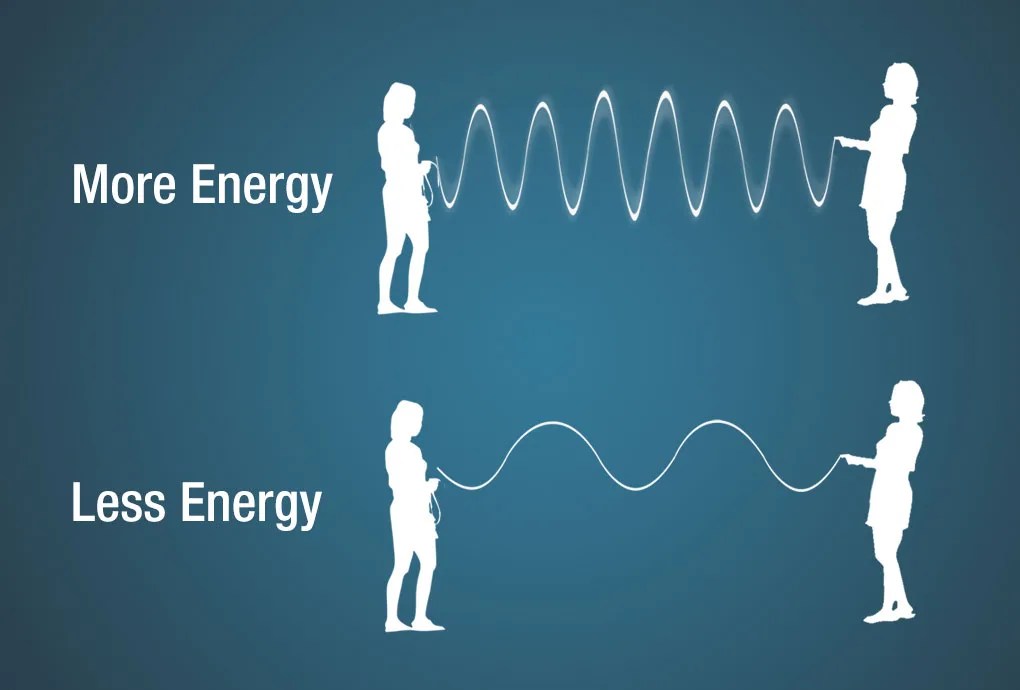
An electromagnetic wave can also be described in terms of its energy—in units of measure called electron volts (eV). An electron volt is the amount of kinetic energy needed to move an electron through one volt potential. Moving along the spectrum from long to short wavelengths, energy increases as the wavelength shortens. Consider a jump rope with its ends being pulled up and down. More energy is needed to make the rope have more waves.
Next: Wave Behaviors
National Aeronautics and Space Administration, Science Mission Directorate. (2010). Anatomy of an Electromagnetic Wave. Retrieved [insert date - e.g. August 10, 2016] , from NASA Science website: http://science.nasa.gov/ems/02_anatomy
Science Mission Directorate. "Anatomy of an Electromagnetic Wave" NASA Science . 2010. National Aeronautics and Space Administration. [insert date - e.g. 10 Aug. 2016] http://science.nasa.gov/ems/02_anatomy
Discover More Topics From NASA
James Webb Space Telescope

Perseverance Rover

Parker Solar Probe

Electromagnetic Radiation
Claimed by Zoila de Leon (Fall 2023)
- 1.1 What is a Electromagnetic(EM) Radiation?
- 1.2 General Properties
- 1.3 Problem Solving Method and Equations
- 1.4 Fields Made by Charges and Fields Made by Monopoles
- 2 The EM Spectrum
- 3 Waves and Fields
- 4 A Mathematical Model
- 5 Connectedness: X-Rays
- 6.1 Practice Problems (new section by Zoila)
- 7 References
What is a Electromagnetic(EM) Radiation?
Electromagnetic radiation is a form of energy that is all around us and takes many forms, such as radio waves, microwaves, infrared, visible light, ultraviolet, x-rays, and gamma rays.
Before 1873, electricity and magnetism were thought to be two different forces. However, in 1873, Scottish Physicist James Maxwell developed his famous theory of electromagnetism. There are four main electro magnetic interactions according to Maxwell:
- The force of attraction or repulsion between electric charges is inversely proportional to the square of the distance between them
- Magnetic poles come in pairs that attract and repel each other much as electric charges do
- An electric current in a wire produces a magnetic field whose direction depends on the direction of the current
- A moving electric field produces a magnetic field, and vice versa
General Properties
The four Maxwell's Equations provide a complete description of possible spatial patterns of electric and magnetic field in space.
- The Ampere-Maxwell Law
- Gauss's Law
- Faraday's Law
Other than Maxwell's Four equations, there are general properties of all electromagnetic radiation:
- Electromagnetic radiation can travel through empty space. Most other types of waves must travel through some sort of substance. For example, sound waves need either a gas, solid, or liquid to pass through in order to be heard
- The speed of light is always a constant (3 x 10^8 m/s)
- Wavelengths are measured between the distances of either crests or troughs. It is usually characterized by the Greek symbol λ (lambda).
Electromagnetic waves are the self-propagating, mutual oscillation of electric and magnetic fields. The propagation of electromagnetic energy is often referred to as radiation. We can also say that the 'pulse' of these moving fields result in radiation (7).
The equation for propagation is E=cB with c being the speed of light. This equation is derived from combining the two equations E=vB and B=u0e0vE, proving that v is equal to 3e8 meters/second.
Problem Solving Method and Equations
To go about solving/analyzing mathematically an electromagnetic field using Maxwell's equations,this is how we proceed (7)
- Establish the space and time in which the electric and magnetic fields are present
- Check that Maxwell's equations can be applied in the situation above
- Check when the charge accelerates, it produces these fields and therefore radiation
- Show how these fields would interact with matter
The equation of the Radiative Electric Field is: E= 1/(4πe0)*-qa/(c^2r) where a is the acceleration of the particle, c is the speed of light and r is the distance from the original location of the charge to right before the kink. This kink happens on the electric field because of the slight delay when the charge is moved.
Fields Made by Charges and Fields Made by Monopoles
We can differentiate fields made by charges and the ones made by magnetic monopoles. (7) For fields made by charges, when the charge is
- at rest, E=1/r^2 and B=0
- constant speed, E=1/r^2 and B=1/r^2
- accelerating, E=1/r and B=1/r
For fields made by magnetic monopoles, the first point would have E and B switched.
The EM Spectrum
EM spectrum is a span of enormous range of wavelengths and frequencies. The EM spectrum is generally divided into 7 different regions, in order of decreasing wavelength and increasing energy and frequency. It ranges from Gamma rays to Long Radio Waves. Following are the lists of waves:
- Visible Light
- Infrared Rays
- Long radio waves
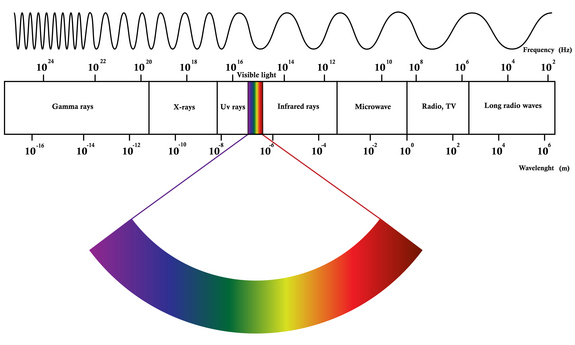
Although all these waves do different things, there is one thing in common : They all travel in waves.
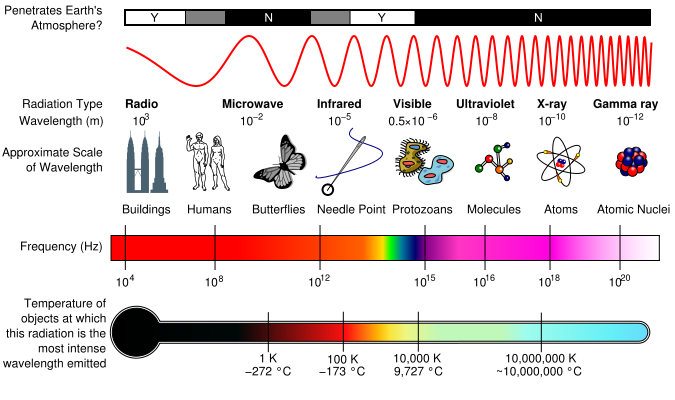
Infrared radiation can be released as heat or thermal energy. It can also be bounced back, which is called near infrared because of its similarities with visible light energy. Infrared Radiation is most commonly used in remote sensing as infrared sensors collect thermal energy, providing us with weather conditions.
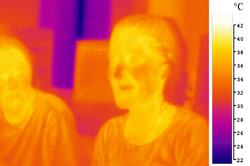
Visible Light is the only part of the electromagnetic spectrum that humans can see with a naked eye. This part of the spectrum includes a range of different colors that all represent a particular wavelength. Rainbows are formed in this way; light passes through matter in which it is absorbed or reflected based on its wavelength. As a result, some colors are reflected more than other, leading to the creation of a rainbow.
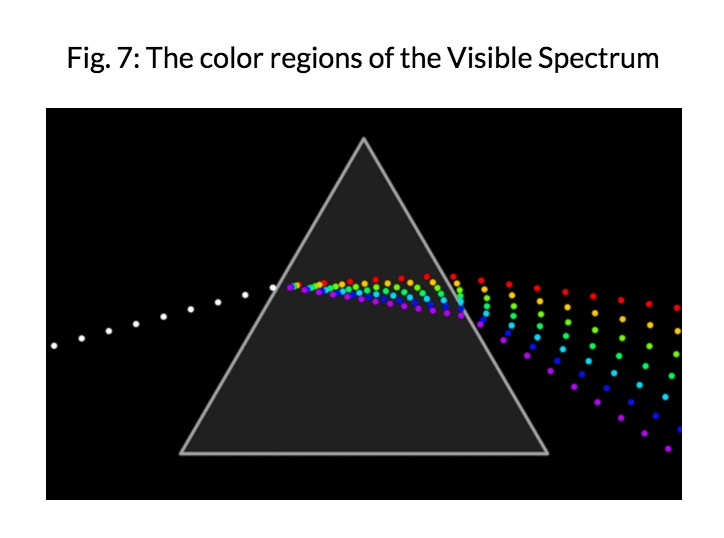
Waves and Fields
As we learned in class, electric field is produced when an electron is accelerating. Likewise, EM radiation is created when an atomic particle, like an electron, is accelerated by an electric field. The movement like this produces oscillating electric and magnetic fields, which travel at right angles to each other in a bundle of light energy called a photon. Photons travel in a harmonic wave at the fastest speed possible in the universe.
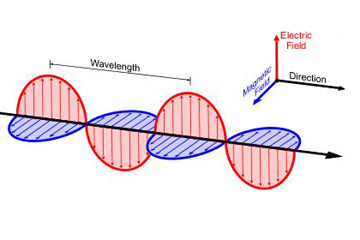
Electromagnetic waves are formed when an electric field couples with a magnetic field. Magnetic and electric fields of an electromagnetic wave are perpendicular to each other and to the direction of the wave.
A wavelength (in m) is the distance between two consecutive peaks of a wave. Frequency is the number of waves that form in a given length of time. A wavelength and frequency are interrelated. A short wavelength indicates that the frequency will be higher because one cycle can pass in a shorter amount of time. Likewise, a longer wavelength has a lower frequency because each cycle takes longer to complete.

Waves can be classified according to their nature:
- Mechanical waves
- Electromagnetic waves
Mechanical Waves
Mechanical waves require a medium (matter) to travel through. Examples are sound waves, water waves, ripples in strings or springs.
Water Waves
Sound Waves
Electromagnetic Waves
Electromagnetic waves do not require a medium (matter) to travel through - they can travel through space. Examples are radio waves, visible light, x-rays.

Radio Waves
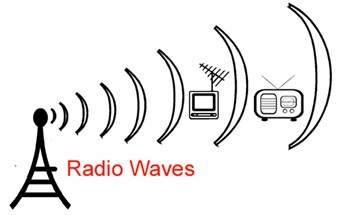
Visible Lights
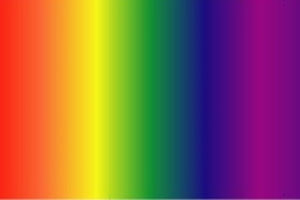
A Mathematical Model
The position of the particle is defined by a sine wave:
y = ymaxsin(wt)
Where w is the angular frequency
Amplitude is the distance from the maximum vertical displacement of the wave to the middle of the wave. The Amplitude of the sinusoidal Wave is the height of the peak in the wave measured from the zero line. This measures the magnitude of oscillation of a particular wave. The Amplitude is important because it tells you the intensity or brightness of a wave in comparison with other waves.
The period of the wave is the time between crests in seconds(s).
T = 2pi/w-----(units of seconds)
Frequency is the number of cycles per second, and is expressed as sec-1 or Hertz(Hz). Frequency is directly proportional to energy and can be express as "
E = hv where E is energy, h is Planck's constant ( 6.62607*10^-34J) and v is frequency
f = 1/T f = w/2pi----(Units Hertz)
Wavelength is the distance between crests in meters. Wavelength is equal to the speed of light times frequency. Longer wavelength waves such as radio waves carry low energy; this is why we can listen to the radio without any harmful consequences. Shorter wavelength waves such as x-rays carry higher energy that can be hazardous to our health.
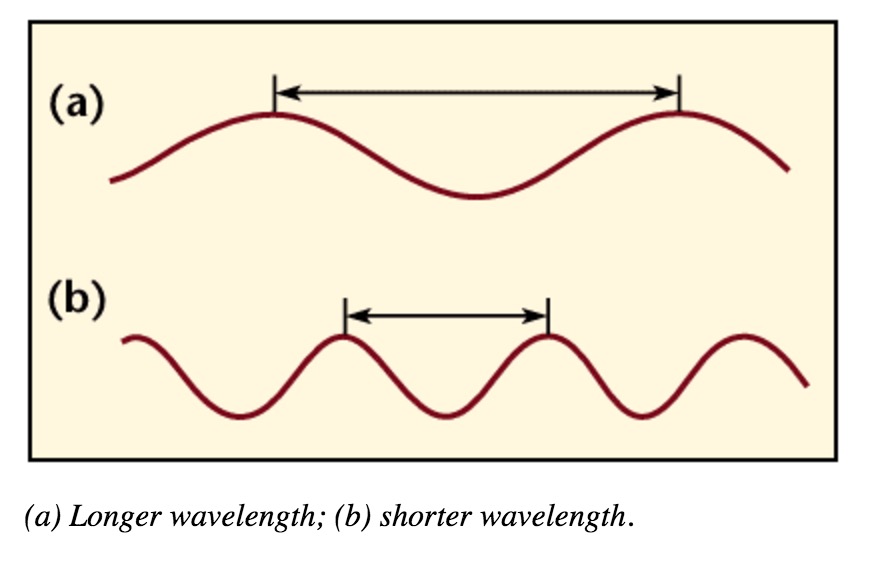
Wavelength and Frequency
The speed of light is the multiplication of the wavelength and frequency.
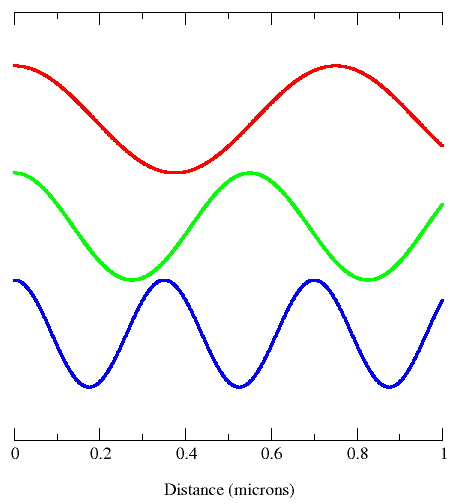
This diagram shows all properties of waves:
ENERGY FLUX
Is defined by the following equation:
Connectedness: X-Rays
Electromagnetic Radiation while commonly thought of as only including visible light, radio waves, UV waves, and gamma rays; also include X-rays. In 1895, X-rays were initially discovered by William Roentgen, who accidentally fell upon the most important discovery about his life (Figure 1). Roentgen was already working on cathode rays, and because of a fluorescent glow that occurred during his experiments, covered his experimental apparatus with heavy black paper. However, when he did this, he discovered a glow coming from a screen several feet away. Through many more experiments, he discovered that a new type of energy, not cathode rays, were the cause of the glow. He named them “x-rays” and received the 1901 Nobel Prize in Physics. Roentgen never patented his monumental discovery and as a result, numerous researchers set out to find a multitude of uses and capitalize on his work.
Primarily, people could now view objects that were hidden from plain view (i.e. scanners in airports). While X-rays are now used in 100’s of professions (security, chemistry, art galleries), its most important function is to view bones to determine abnormalities in humans. In fact, one of Roentgen’s first x-rays was of his wife’s hand (Figure 2). X-rays fall under the scope of electromagnetic radiation because, like all E.R. waves, it is comprised of photons. X-rays have wavelengths between 0.01 to 10 nanometers and fall between UV and Gamma Waves on the E.R. spectrum (Figure 3). There are two main methods in which an x-ray may be formed. Both require a vacuum-filled tube called an x-ray tube (Figure 4). With an anode on one end and a cathode on the other, an electric current is applied and a high energy electron is projected from the cathode, through the vacuum, and at the anode. In the characteristic x-ray generation approach, the electron from the cathode collides with an inner shell electron on an atom on the anode (Figure 5). Both of these electrons are ejected from the atom and an outer shell electron takes the place of the inner shell one. Because the outer electron must have a lower energy to fill the inner shell hole, it releases a photon with the equivalent energy of the difference between the two energy levels in the atom. This photon is the x-ray that is used to view objects such as bones.
In the Bremsstrahlung x-ray generation method, the electron from the cathode is slowed as it passes the nucleus of an atom at the anode (Figure 6). As it slows and its path is changed, the loses energy (kinetic energy). This energy is also released as a photon which is subsequently called an x-ray. Depending on the voltage and current of the tube and the material of the anode, different types (as in wavelengths and energy) of x-rays can be produced and each one. However, all X-rays will continue to pass through objects until it reaches a material dense that stops it. However, density of the material required depends on the energy of the x-ray. For example, during a medical x-ray, x-rays of a certain energy will pass through soft tissue (skin, organs, etc) but not through bones. The x-rays that pass through the soft tissue will strike the screen and the absence of the x-rays absorbed by the bones will cause a negative space on the screen. The areas where x-rays do not strike will form the image of the bone. While the principles remain the same, x-ray machines today use incredible sophisticated technology to specify the type of x-ray they want and have greatly increased in accuracy since Roentgen’s initial discovery.
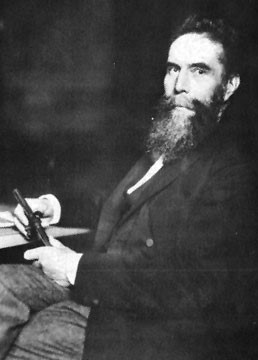
- Information and photographs are pulled from references 1 through 5 cited below*
Already, during the Ancient Greek and Roman times, light was studied as the presence of deflection and refraction were noticed. Electromagnetic radiation of wavelengths in the early 19th century. The discovery of infrared radiation is ascribed to astronomer William Herschel, who published his results in 1800 before the Royal Society of London. Herschel used a glass Triangular prism (optics)|prism to refract light from the Sun and detected invisible rays that caused heating beyond the red part of the spectrum, through an increase in the temperature recorded with a thermometer. These "calorific rays" were later termed infrared.
In 1801, Rohann Ritter, discovered the presence of ultraviolet light using salts. It was known that light could darken some silver halides and while doing so, he realized that the region beyond the violet bar (therefore ultraviolet) was more effective in changing the color of the halides. However,in 1864, while summarizing the theories of his time accumulating into his famous set of Maxwell equations, James Clerk Maxwell managed to deduce the speed of light being around 3e8 meters per second. This was instrumental in creating the rest of the spectrum.
In 1887-1888 Physicist Heinrich Hertz not only tried to measure the velocity and frequency of electromagnetic radiation waves at other parts of the known spectrum of the time, but he was also able to prove that Maxwell's findings were correct. He did this on the microwave radiation as well.
The discovery of X-rays occurred in 1895 by Wilhelm Rontgen when his barium platinocyanide detector screen began to glow under the presence of a discharge that passed through a cathode ray tube although the latter was completely covered. Once he determined its possible use, he tried to look at his wife's hand using this new discovery. However x-ray spectroscopy was not institutionalized until later by Karl Manne Siegbahn.
In 1900, Paul Villard discovered Gamma rays although he initially thought that they were particles similar to alpha and beta particles which were emitted during radiation. These 'particles' were later proven to be part of the electromagnetic spectrum.
Practice Problems (new section by Zoila)
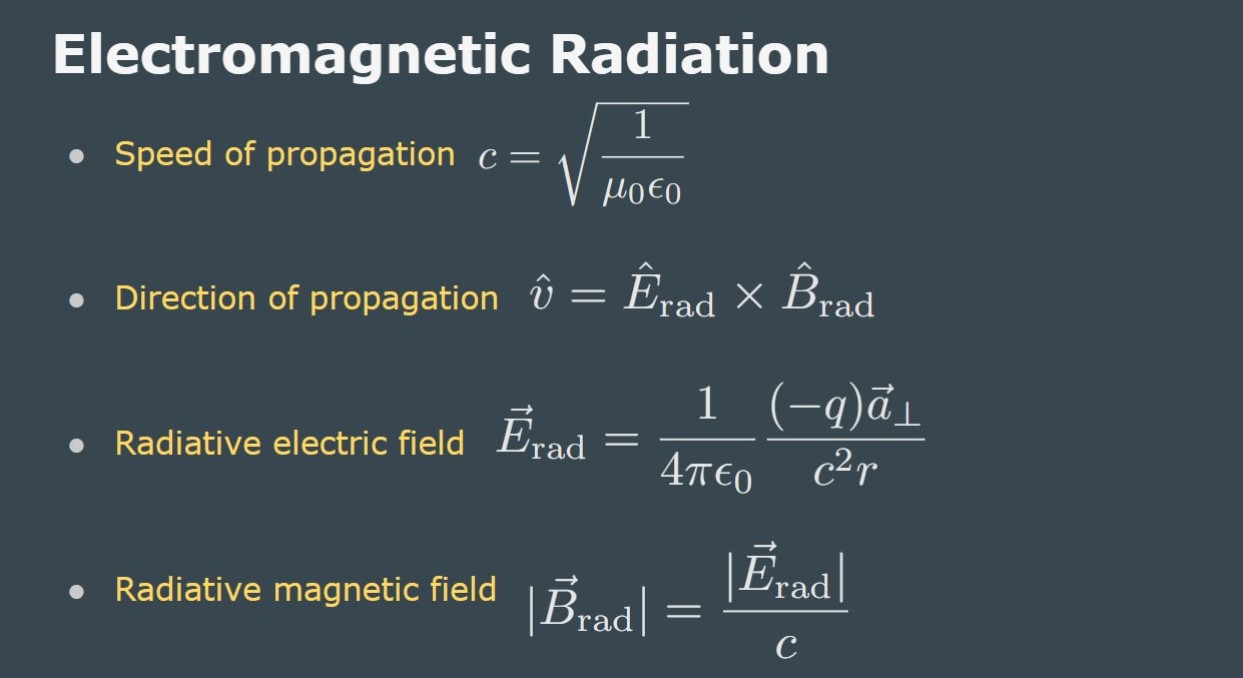
1. Elert, Glenn. "X-rays." X-rays – The Physics Hypertextbook. N.p., n.d. Web. 08 Apr. 2017. http://physics.info/x-ray/
2."X-rays." X-rays. N.p., n.d. Web. 08 Apr. 2017. http://www.physics.isu.edu/radinf/xray.htm
3. "Basics of X-ray PhysicsX-ray production." Welcome to Radiology Masterclass. N.p., n.d. Web. 08 Apr. 2017. http://www.radiologymasterclass.co.uk/tutorials/physics/x-ray_physics_production#top_2nd_img
4. "X-Rays." Image: Electromagnetic Spectrum. N.p., n.d. Web. 08 Apr. 2017. https://www.boundless.com/physics/textbooks/boundless-physics-textbook/electromagnetic-waves-23/the-electromagnetic-spectrum-165/x-rays-597-11175/images/electromagnetic-spectrum/
5. "This Month in Physics History." American Physical Society. N.p., n.d. Web. 08 Apr. 2017. https://www.aps.org/publications/apsnews/200111/history.cfm
6. Editors, Spectroscopy. “The Electromagnetic Spectrum: A History.” Spectroscopy Home, 27 Oct. 2017, www.spectroscopyonline.com/electromagnetic-spectrum-history?id=&sk=&date=&&pageID=4.
7. Chabay, Ruth W., and Bruce A. Sherwood. Matter & Interaction II: Electric & Magnetic Interactions, Version 1.2. John Wiley & Sons, 2003.
Navigation menu
NOTIFICATIONS
Light basics.
- + Create new collection
Light is a form of energy produced by a light source. Light is made of photons that travel very fast. Photons of light behave like both waves and particles.
Light sources
Something that produces light is called a light source. There are two main kinds of light sources:

Fireworks show how light travels faster than sound. We see the light almost instantly, but the sound arrives later. To work out how many kilometres away the fireworks are, count the seconds until you hear the bang and divide by 3.
Incandescent sources use heat to produce light. Nearly all solids, liquids and gases will start to glow with a dull red colour once they reach a temperature of about 525 °C. At about 2300 °C, the filament in a light bulb will start to produce all of the colours of the visible spectrum, so it will look white. The Sun, stars, a flame and molten metal are all incandescent.
Luminescent sources are normally cooler and can be produced by chemical reactions, such as in a glowstick or a glow-worm. Other luminescent sources include a computer screen, fluorescent lights and LEDs.
Light travels much faster than sound
Light travels at a speed of 299,792,458 m/s (that’s nearly 300,000 km/s!). The distance around the Earth is 40,000 km, so in 1 second, light could travel seven and a half times around the world.
Sound only travels at about 330 m/s through the air, so light is nearly a million times faster than sound.
If lightning flashes 1 kilometre away from you, the light reaches you in 3 millionths of a second, which is almost instantly. The sound of the thunder takes 3 seconds to travel 1 kilometre – to work out many kilometres away lightning is, count the seconds for the thunder to arrive and divide by 3.
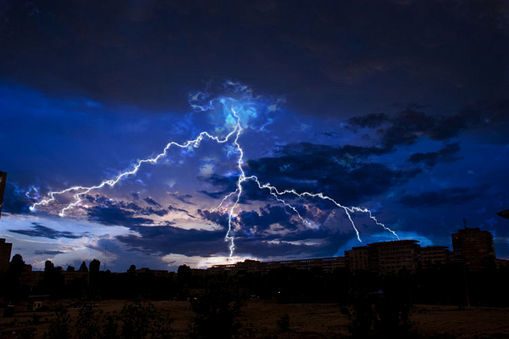
Lightning storms are important for converting nitrogen gas in the atmosphere through to forms that are biologically available.
Light takes about 8 minutes and 20 seconds to reach the Earth from the Sun. When we see the Sun, we are seeing what it looked like over 8 minutes ago.
Light can travel through empty space
Unlike sound, which needs a medium (like air or water) to travel through, light can travel in the vacuum of space.
Light travels in straight lines
Once light has been produced, it will keep travelling in a straight line until it hits something else.
Shadows are evidence of light travelling in straight lines. An object blocks light so that it can’t reach the surface where we see the shadow. Light fills up all of the space before it hits the object, but the whole region between the object and the surface is in shadow. Shadows don’t appear totally dark because there is still some light reaching the surface that has been reflected off other objects.
Once light has hit another surface or particles, it is then absorbed, reflected (bounces off), scattered (bounces off in all directions), refracted (direction and speed changes) or transmitted (passes straight through).
Models for light
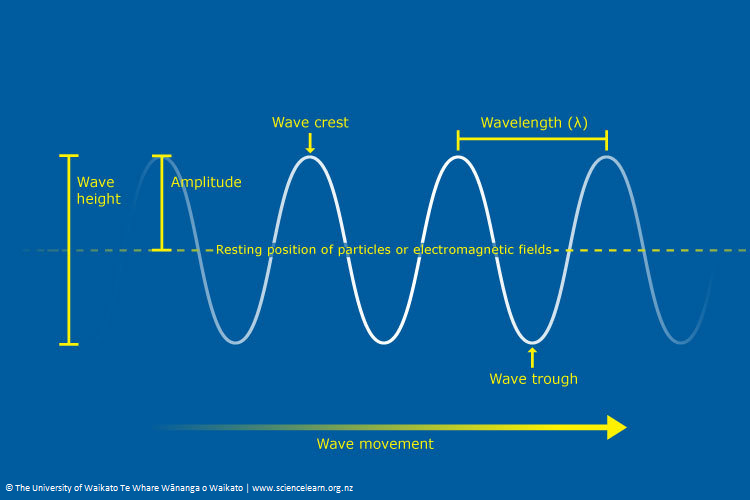
Wave length, height and frequency
A wave can be described by its length, height (amplitude) and frequency.
Light as waves
Rainbows and prisms can split white light up into different colours. Experiments can be used to show that each of these colours has a different wavelength.
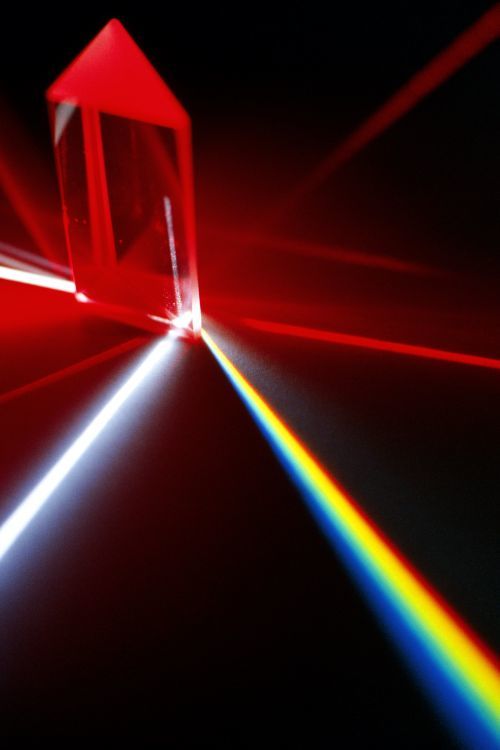
When white light shines through a prism, each colour refracts at a slightly different angle. Violet light refracts slightly more than red light. A prism can be used to show the seven colours of the spectrum that make up white light.
At the beach, the wavelength of water waves might be measured in metres, but the wavelength of light is measured in nanometres – 10 -9 (0.000,000,001) of a metre. Red light has a wavelength of nearly 700 nm (that’s 7 ten-thousandths of a millimetre) while violet light is only 400 nm (4 ten-thousandths of a millimetre).
Visible light is only a very small part of the electromagnetic spectrum – it’s just that this is the range of wavelengths our eyes can detect.
Light as particles
In 1905, Albert Einstein proposed that light is made of billions of small packets of energy that we now call photons. These photons have no mass, but each photon has a specific amount of energy that depends on its frequency (number of vibrations per second). Each photon still has a wavelength. Shorter wavelength photons have more energy.
The photoelectric effect
University of Waikato science researcher Dr Adrian Dorrington explains the photoelectric effect. He then describes how camera sensors can be designed on the basis of this effect to enable light energy to be converted into electric potential energy.
The photoelectric effect is when light can cause electrons to jump out of a metal. These experiments confirm that light is made of these massless particles called photons.
Simple explanations of some of these concepts can be found in the article Building Science Concepts: Shadows .
Nature of science
In order to understand the world we live in, scientists often use models. Sometimes, several models are needed to explain the properties and behaviours of a phenomenon. For example, to understand the behaviour of light, two models are needed. Light needs to be thought of as both waves and particles.
Useful links
Even though light doesn’t have mass, learn how it still has a tiny amount of momentum. Find out about NASA’s solar sails to power spacecraft.
Read about the LightSail project, a crowdfunded project from The Planetary Society, aiming to demonstrate that solar sailing is a viable means of propulsion for CubeSats (miniature satellites intended for low Earth orbit).
Explore solar sails more in your classroom, with this activity Solar Sails: The Future of Space Travel from the TeachEngineering website.
See our newsletters here .
Would you like to take a short survey?
This survey will open in a new tab and you can fill it out after your visit to the site.
If you're seeing this message, it means we're having trouble loading external resources on our website.
If you're behind a web filter, please make sure that the domains *.kastatic.org and *.kasandbox.org are unblocked.
To log in and use all the features of Khan Academy, please enable JavaScript in your browser.
Middle school physics - NGSS
Course: middle school physics - ngss > unit 4, mechanical waves and light.
- Understand: mechanical waves and light
Key points:
- Sound waves, water waves, and seismic waves are all types of mechanical waves.
- Light is a form of electromagnetic wave.
- A light wave’s amplitude determines how intense, or bright, it is. Its frequency determines the light wave’s color.
- A sound wave’s amplitude determines how loud it is. Its frequency determines the sound wave’s pitch.
Want to join the conversation?
- Upvote Button navigates to signup page
- Downvote Button navigates to signup page
- Flag Button navigates to signup page

Find what you need to study
8 min read • december 31, 2022
Saarah Hasan
Daniella Garcia-Loos
What is a wave? Well, in simple terms, a wave can be described as a disturbance that carries energy through a medium— the substance/material that carries the wave—from one place to another. Waves transfer energy without transferring matter; energy moves from place to place, yet the particles of matter in the medium return to their original location.
Let’s take a look at this in a real-life example.
Imagine a stadium wave. Each person in the audience stands up and then quickly sits back down to make the wave. The disturbance travels through the stadium, but the people in the audience don’t move from where their seat is. They don’t walk around the stadium to make the wave.
Properties of Waves
While all waves share some basic properties, they can come in different shapes and forms. It’s common to categorize waves based on certain characteristics:
- Transverse Wave — A wave in which particles of the medium move in a direction perpendicular to the motion of the wave.
- Longitudinal Wave— A wave in which particles of the medium move parallel to the motion of the wave.
- Mechanical Wave— A wave that isn’t capable of transmitting its energy through a vacuum ; mechanical waves require a medium to travel and can be both longitudinal or transverse.
- Electromagnetic Wave — A wave that’s capable of transmitting its energy through a vacuum; electromagnetic waves are produced by the vibrations of charged particles and are always transverse.

Longitudinal vs Transverse Waves
Longitudinal waves are waves in which the disturbance travels in the same direction as the wave itself. These waves involve a compressional motion, in which the particles of the medium move back and forth along the direction of the wave.
Transverse waves are waves in which the disturbance travels perpendicular to the direction of the wave itself. These waves involve a lateral motion, in which the particles of the medium move up and down or side to side in a direction that is perpendicular to the direction of the wave.
An example of a longitudinal wave is a sound wave, which travels through the air as a series of compressions and rarefactions. An example of a transverse wave is a water wave, which travels through a body of water as a series of crests and troughs.
Mechanical vs Electromagnetic Waves
Mechanical waves are waves that require a medium , or a physical substance, to propagate through. Examples of mechanical waves include sound waves, which require a medium such as air or water to travel through, and surface waves, which require a solid surface such as the ground or the surface of a lake.
Electromagnetic waves are waves that do not require a medium to propagate through. They can travel through empty space, as well as through various materials such as air, water, or metal. Examples of electromagnetic waves include light, radio waves, and X-rays.
The main difference between mechanical and electromagnetic waves is the way in which they transfer energy. Mechanical waves transfer energy through the movement of particles in the medium, while electromagnetic waves transfer energy through the oscillation of electric and magnetic fields.
Anatomy of Waves
Let’s take a closer look at the parts of waves.🔎
Transverse Waves:
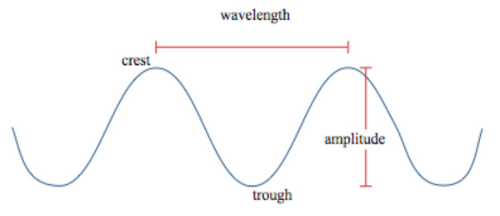
Taken from Wikimedia Commons
Longitudinal Waves:
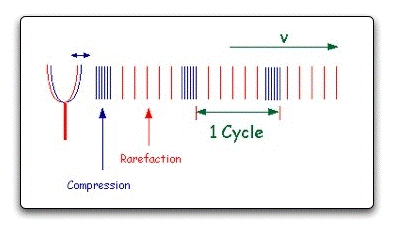
- Wavelength (λ)— The distance/length of the wave measured from two identical points, from crest to crest or from trough to trough ; it’s the length of one complete wave cycle.
- Amplitude (a)— The height of the wave or distance from rest to max. displacement. Amplitude is proportional to the amount of energy carried by a wave: a high energy wave has a high amplitude; a low energy wave has a low wave.
- Crest — The point on a wave where the amount of positive/upward displacement from rest is at a max.
- Trough — The point on a wave where the amount of negative/downward displacement from rest is at a max.
- Compression — A region in a longitudinal wave where the particles are closest together (max. density).
- Rarefaction — A region in a longitudinal wave where the particles are farthest apart (min. density).
- Frequency (f)— The number of waves made per second; measured in Hertz (Hz)
- Period (T)— The amount of time it takes to make one wave; measured in seconds (s).
Polarization is the property of a wave that describes the direction of its vibration. In a polarized wave, the vibration of the particles in the medium is oriented in a specific direction, rather than being randomly oriented. Polarization is an important property of waves because it determines how the wave will interact with certain materials and how it will be absorbed or reflected by those materials.
Wave Equations
👇Let’s jot down the formulas/equations we’ll need to solve wave-related physics problems.👇
T=1/f f =1/ T
The frequency is the reciprocal of the period and vice versa.
speed =distance/time
For waves, the speed is the distance traveled by a point (like the crest / trough ) on the wave over a given amount of time. In the time of one period, a wave moves the distance of one wavelength. So from that, we can say:
Speed =Wavelength/Period ➡️ v=λ/T v = λ / T
Speed =Wavelength*Frequency ➡️ v=λ*f v = λ ∗ f
While wave speed is calculated by multiplying frequency and wavelength, changing either of the two doesn’t affect wave speed . The speed of a wave depends upon the medium in which the wave travels.
Check out this interactive to explore this concept further.
Let's walk through an example problem:
You are given a graph of the displacement of a mechanical wave as it travels through a medium. The wave is shown as a function of time (t) and distance (x). The wave is propagating in the positive x direction.
Your task is to:
- Analyze the graph to determine whether the wave is polarized.
- If the wave is polarized, identify the direction of polarization .
- Explain why the wave must have a vibration perpendicular to the direction of energy propagation.
- To determine whether the wave is polarized, we need to look at the shape of the waveform in the graph. If the waveform is symmetrical about a central axis, then the wave is unpolarized. If the waveform is asymmetrical and has a specific orientation, then the wave is polarized.
In this case, the waveform appears to be asymmetrical and oriented in a specific direction, so we can conclude that the wave is polarized.
2. To identify the direction of polarization , we need to look at the orientation of the waveform. If the waveform is oriented along the x-axis, then the wave is horizontally polarized. If the waveform is oriented along the y-axis, then the wave is vertically polarized.
In this case, the waveform appears to be oriented along the y-axis, so we can conclude that the wave is vertically polarized.
3. To explain why the wave must have a vibration perpendicular to the direction of energy propagation, we can use the concept of polarization . Polarization refers to the direction of the vibration of the wave. In a vertically polarized wave, the vibration is perpendicular to the direction of energy propagation. This means that the energy of the wave is being transmitted primarily in the x direction, while the vibration of the particles in the medium is occurring in the y direction.
This is why a polarized wave must have a vibration perpendicular to the direction of energy propagation. The energy of the wave is transmitted in one direction, while the vibration of the particles in the medium is occurring in a different direction.
Practice Problems:
1. Which of the following statements about the speed of waves on a string are true? I. The speed depends on the tension in the string II. The speed depends on the frequency III. The speed depends on the mass per unit length of the string.
B) I and II only
C) I and III only
D) II and III only
E) I, II and III
2. A wave has a frequency of 50 Hz. The period of the wave is:
3. If the frequency of sound is doubled, the wavelength:
A) halves and the speed remains unchanged B) doubles and the speed remains unchanged C) is unchanged and the speed doubles D) is unchanged and the speed halves E) halves and the speed halves
4. An observer hears a sound with a frequency of 400 Hz. Its wavelength is approximately:
5. As sound travels from steel into air, both its speed and its:
A) wavelength increase
B) wavelength decrease
C) frequency increase
D) frequency decrease
E) frequency remain unchanged
C: Based on the formula
E: Use T = 1/f
A: Frequency and wavelength are inverse
A: Speed of sound is 340, use v = f λ
B: When sound travels into less dense medium, its speed decreases (unlike light) … however, like all waves when traveling between two mediums, the frequency remains constant. Based on v = f λ, if the speed decreases and the frequency is constant then the λ must decrease also.
Key Terms to Review ( 12 )
Compression
Electromagnetic wave
Frequency (f)
Polarization
Rarefaction
Speed=Wavelength/Period (v=λ/T)
Transverse wave

Stay Connected
© 2024 Fiveable Inc. All rights reserved.
AP® and SAT® are trademarks registered by the College Board, which is not affiliated with, and does not endorse this website.
The Nature of Waves
A wave is a disturbance that propagates through a medium. There are three words in that definition that may need unpacking: disturbance, propagate, and medium.
- a change in a kinematic variable like position, velocity, or acceleration;
- a change in an intensive property like pressure, density, or temperature;
- a change in field strength like electric field strength, magnetic field strength, or gravitational field strength.
- To propagate , in the sense used in this definition, is to transmit the influence of something in a particular direction. Synonyms for propagate include spread, transmit, communicate, and broadcast. The noun form of the word is propagation .
- A medium is the substance through which a wave can propagate. Water is the medium of ocean waves. Air is the medium through which we hear sound waves. The electric and magnetic fields are the medium of light. People are the medium of a stadium wave. The Earth is the medium of seismic waves (earthquake waves). Cell membranes are the medium of nerve impulses. Transmission lines are the medium of alternating current electric power. Medium is the singuar form of the noun. Media is the plural form (although mediums is prefered by some people).
Let's list a few key examples of wave phenomena and then connect them to this definition. The first example that comes to mind when most people hear the word wave are the kinds of waves that one sees on the surface of a body of water: deep water waves in the ocean or ripples in a puddle. The most important kinds of waves for humans are the waves we use to sense the world around us: sound and light.
Imagine a calm pool. The surface is flat and smooth. Drop a rock into it. Kerploop. The surface is now disturbed. It is higher than normal in some places and lower than normal in others. The disturbed water at the point of impact disturbs the water next to it, which in turn disturbs the water next to it, which disturbs the water next to it, and so on. The disturbance spreads outward, transmits, or propagates. The medium through which this disturbance propagates is the surface of the water.
Imagine a quiet room. The air inside is still. Drop a book onto a table in that room. Thwap. The air between the book and the table is squeezed out in a fraction of a second. The air pressure in that rapidly decreasing gap rises above normal and then rebounds. The rise and fall of pressure is like the rise and fall of the surface of the pool in the previous example. The air under the book bumps the air on the edges of the book, which bumps the air next to it, which bumps the air next to it, and so on. The medium through which this disturbance propagates is the air.
Those were the easy examples. Water waves and sound waves are examples of mechanical waves — waves that propagate through a material medium. Light is not so easy to understand as a wave, which is why there are multiple sections of this book devoted to it. Still, I am going to try to describe it briefly.
Imagine a dark cavern, deep within the Earth. The electric and magnetic fields inside are relatively static and unchanging. Strike a match. Skeerach. The atoms of carbon in the wood of the matchstick combine with the atoms of oxygen in the air releasing heat. The heat agitates the atoms of the combustion products resulting in the phenomenon known as fire. The electrons bound to the rapidly vibrating atoms disturb the electric and magnetic fields in the space surrounding them. These fields are "elastic" in a sense. A wiggle in the fields in one place causes a wiggle in the fields nearby, which causes a wiggle in the fields nearby, and so on. These wiggles eventually make it to your eye, which you perceive as light. The electric and magnetic fields that fill all of space are the medium.
essential property
Waves transfer energy, momentum, and information, but not mass.
A naive description of a wave is that it has something to do with motion. But the motion of a wave on the water is not the same as the motion of the water from a hose. When waves move over the surface of the ocean, where does the ocean go? Nowhere. When waves reach the shore, does the water accumulate into great heaps? No. The water moves in and out, and the ocean stays behind. Even when huge tsunamis strike, the wall of water deposited on the land eventually drains back into the sea. In this case, no net transfer of mass has occurred.
Compare this to the water from a hose. The water comes pouring out the open end and stays where it lands forming a puddle or drains away to some other location. It most certainly does not jump back into the hose. In this case, mass has been transferred from one location to another.
Any sensible person who owns waterfront property should be familiar with the word erosion. Ocean waves (or waves on the Great Lakes for that matter) break on the shore, beating the rock and soil into submission and pulling it away. This material will never return. (If there were no plate tectonic forces lifting the land up in some places or volcanoes creating new land in others, the Earth would be covered in a global sea of uniform depth.) A force ( F ) has been exerted and mass has been displaced ( ∆ s ). Work has been done ( W = F ∆ s ). The ability to do work is one definition of energy ( W = ∆ E ). Thus waves transfer energy.
Sticking with the example of ocean waves, anyone who surfs knows that waves transfer momentum. I have less to say on this subject.
Sound and light are the two primary examples of the way we gather information around us as humans. We have specialized sensory organs called ears and eyes for doing just that.
Here's a list of some phenomena or activities that satisfy the definition of a wave given above.
- including hock waves
- Radio waves
- Visible light
- Ultraviolet
- Tsunamis (tidal waves)
- Ripples (capillary waves)
- P waves (primary waves, pressure waves)
- S waves (secondary waves, shear waves)
- R waves (Rayleigh waves, ground roll)
- L waves (Love waves)
- A fluttering flag
- Snapping a sheet when making a bed
- Nerve impulses
- Peristalsis
- Heart contractions
- Snakes, eels, etc
- Worms, slugs, etc.
- Centipedes, millipedes, caterpillars, etc.
- Plucking, bowing, or striking a guitar, violin, or piano string
- Casting loops when fly fishing
- Cracking a whip
- Gravitational waves (as described in general relativity, not to be confused with gravity waves in water)
- Matter waves (quantum mechanical waves, de Broglie waves)
- Dominoes (as a show, not as a game)
- Stadium wave (Mexican wave, the wave)
- Newton's cradle (paid link)
not examples
Just because the word wave is used doesn't mean the thing being described is a wave in the sense used in this book.
- Waving as a signal to get someone's attention or to greet them or to say goodbye is not a wave. It does not propagate in a direction. Just because you wave at me does not mean that I have to start waving followed by a person behind me and the person behind them and the person behind them.
- A permanent wave set in a person's hair is not a wave. The term is almost an oxymoron. Nothing's moving if a thing is permanent. Also, you getting a wave set in your hair does not result in the people nearest you getting one followed by the people next to them getting one, and so on, until the whole globe is filled with wavy haired people.
- Wheat, or any other tall grass, is sometimes said to wave when gusts of wind pass over it. That bulk flow of matter is not a wave and neither is the response of the wheat.
- A heat wave is a meteorological term referring to a prolonged period of unusually high temperature. This definition has no connection to a phenomenon that propagates. Just because it's hot for a long period in one location does not imply that the heat wave will propagate to another location. It's actually sort of the opposite. A heat wave is often a region where the hot air is "stuck". The opposite of a heat wave could be called a cold wave, but it's usually described a cold snap (at least in the dialect of English I'm used to hearing). This should indicate that neither one of these phenomena is really a wave. Sometimes infrared radiation is described colloquially as heat waves, but that's not the right term. The same goes for rising thermals in the desert. That shimmering effect sometimes seen on the horizon is turbulent air of different density streaming upward and not a wave. Waves do not transfer mass.
- A crime wave is like a heat wave, but for crime. Since heat waves aren't waves, neither are crime waves.
- Making waves, meaning to stir up trouble, is not an example of a wave — and don't you disagree with me you trouble maker.
Classification of waves
Waves can be classified according to the medium through which they propagate.
by the type of disturbance
Waves can be classified according to the type of disturbance — meaning its relative direction or shap. There is a lot that can be said about this organizational scheme. I'm starting this part of this section with a quick summary in table form followed by a rather detailed follow up.
transverse waves
A transverse wave is one in which the direction of the disturbance is perpendicular to the direction of propagation. The word transverse describes something pointing in a sideways or lateral direction. As dynamic phenomena, waves are better represented with animations than with static images. Click on the static image below to see a transverse wave in action.
A cartoon representation of this kind of wave is your classic wiggly line. People with a bit of math knowledge will tell you they drew a sine curve. Those with a little bit more math knowledge will say they drew a sine or cosine curve.
The high parts on a curve like this are called crests . The low parts are called troughs . Since directions like up and down don't always make sense for waves, what the parts really represent are the maximal changes. The points labeled crests are points corresponding to a maximal increase of the changing quantity in a whatever direction is decided to be positive. The points labeled troughs are the points corresponding to the maximal change in the opposite direction.
Pronouncing words ending in -ough in English is often a mystery. The word trough rhymes with off. A trough is what one uses to provide food and water to livestock and other domesticated animals — typically a long, narrow open container that an animal would dip its head down into. The word crest rhymes with best. A crest is something at the top of something. Many birds, usually male birds, have crests. Hills and mountains are are sometimes said to have crests. The crest on a men's sports jacket or a school uniform gets its name from the heraldic crests that were originally worn on knight's helmets above the visor. Crests are up high. Troughs are down low.
The most important example of a transverse wave for humans is light. Most of what I am about to say in the following bullets will really be discussed elsewhere in this book.
- Showing that light is a just wave was not easy before the 20th century. Now that we have easy access to lasers in the 21st century, it's less of a problem. Light can be made to interfere with itself and produce a pattern of what are called interference fringes . A laser and two or more closely spaced openings are all that is needed. The iridescence seen when gasoline is spilled on water, in some insects like scarab beetles and butterflies, and in pearls and the shells of mollusks is caused by thin film interference . Observing this wave behavior of light requires no special technology.
- Showing that light is a transverse wave was was also not easy before the 20th century. Now that we have easy access to polarized sunglasses and polarized electronic displays in the 21st century, it's less of a problem. Light can be shown to exhibit polarization . Try looking at certain electronic displays with polarized sunglasses. If the orientation of the sunglasses is perpendicular to the orientation of the display, the display will look dark (or really screwed up). If the orientation is parallel, the display will look normal (or closer to normal than when they were perpendicular).
Lots of musical instruments make use of transverse waves to generate their characteristic sound.
- The source of the sound that comes out of violins, guitars, pianos and other chordophones is the side to side motion of a nylon or metal string (or in the olden days, dried animal intestines). The parts of the string vibrate side to side, but the wave travels along the length of the string. These two directions are perpendicular, which makes the waves transverse. The vibrations of the string are also transmitted into the wooded bodies or sound boards of these instruments. These flat wooden parts are driven to flex in and out, but the energy propagates across the surface. The two directions here are also perpendicular.
- The source of the sound that comes out of drum heads, kazoos or other membranophones is the in and out vibration of some flat, membrane-like structure. The waves produced by striking, stroking, or humming into these devices generates waves that crisscross the object. Once again, the disturbance is perpendicular to the propagation.
- Most percussion instruments that are not drums are classified as idiophones . Cymbals, triangles, and xylophones produce sound by the vibration of the entire object or a piece that is not a string, membrane, or column of air. The waves set up in many of these instruments are transverse, but because the class is so large and varied there is probably an exception out there somewhere.
Some animals propel themselves by sending transverse waves down the length of their bodies.
- Fish use a variety of means for getting around but long, thin, tubular fish like eels, lamprey, and dogfish are what comes to mind when I think about locomotion by transverse waves. A wave of side to side motion starts at the head and propagates backward along the spine. This propels the fish forward.
- Snakes also have several mechanisms for propelling themselves. The one that is considered most "normal" is called lateral undulation and has the classic look of a transverse wave in a one-dimensional medium. Much like the fish described above, a wave starts at the head as side to side motion and propagates backward down the length of the snake. A fancier kind of locomotion that relies on transverse waves is called sidewinding and the snakes that use it live in sandy deserts or slippery mud flats — anywhere getting a good grip on the ground is difficult. It's still an example of a transverse wave, but it propels the snake diagonally instead of forward relative to its body axis.
longitudinal waves
- pressure, compression, density
- aerophones - vibrating columns of air (horns, whistles, organ pipes )
- primary (P) pressure
- invertebrates (worms)
- traffic jams
- density waves in spiral galaxies generate the arms
- compressions (a.k.a. condensation): the pressed part, the greatest positive pressure change, a region where the medium is under compression
- rarefactions (a.k.a. dilations): the stretched part, the lowest negative pressure change, a region where the medium is under tension
complex waves
classed by orientation of change
- P rimary (surface, compression, P ressure)
- S econdary (transverse, S hear), can't propagate through liquids
- L ove, ( L ateral shear)
- R ayleigh, (elliptical, plate waves, ground R oll), something like ocean waves, but elliptical instead of circular
torsional waves
By duration.
classified by duration
by appearance
Waves can be classified according to what they appear to be doing.
Now look at these pretty, moving pictures.
- Testimonials
- Publications
- Class Schedule
- Terms and Conditions
- JC Syllabus
- IP/Secondary
The Basics of Waves: A Guide to Everything You Need to Know

Waves are all around us, from the sound waves that enable us to hear music and conversations to the light waves that allow us to see the world around us. Despite their ubiquitous nature, many people are unfamiliar with the basics of waves. In this article, we will explore what waves are, how they work, and the different types of waves.
What are Waves?
At its most basic level, a wave is a disturbance that travels through a medium. Waves transfer energy from one point to another without transferring matter. Waves work by transferring energy through a medium, causing the particles of the medium to vibrate or oscillate. These vibrations create a disturbance that travels through the medium, and the wave moves from one point to another.
There are several types of waves, including mechanical waves, electromagnetic waves, transverse waves, longitudinal waves, and surface waves. Mechanical waves require a medium to travel through, whereas electromagnetic waves can traverse through a vacuum or empty space without any medium. Transverse waves move perpendicular to the direction of the wave, while longitudinal waves move parallel to the direction of the wave. Surface waves travel along the surface of a medium.
How do Waves Work?
Waves work by transferring energy through a medium. This energy can be in the form of sound, light, or motion. When a wave travels through a medium, it causes the particles of the medium to vibrate or oscillate. These vibrations create a disturbance that travels through the medium, and the wave moves from one point to another.
Types of Waves
There are several types of waves, including:
Mechanical Waves: These are waves that require a medium to travel through. Examples of mechanical waves include sound waves and water waves.
Electromagnetic Waves: These are waves that can travel through a vacuum or empty space. Examples of electromagnetic waves include light waves, radio waves, and microwaves.
Transverse Waves: These are waves where the particles in the medium move perpendicular to the direction of the wave. Examples of transverse waves include light waves and water waves.
Longitudinal Waves: These are waves where the particles in the medium move parallel to the direction of the wave. Examples of longitudinal waves include sound waves and seismic waves.
Surface Waves: These are waves that travel along the surface of a medium. Examples of surface waves include water waves.
Waves are a fascinating and integral part of our world. They allow us to see, hear, and experience the world around us. Waves come in many different forms and can travel through various mediums. Understanding the basics of waves is crucial to understanding many of the phenomena we encounter daily.
As we continue to explore the world of waves, we discover new ways they impact our lives. From medical imaging to communication technologies, waves play a vital role in many areas of science and technology. By gaining a deeper understanding of waves, we can continue to unlock the universe’s secrets and harness their power to make the world a better place.
If you want to learn more about other such interesting Physics concepts, Tuition Physics is a premium O Level physics tuition centre in Singapore. We are staffed by well-trained teachers who are dedicated to providing you with the best supplementary education. Contact us today to learn more!
TuitionPhysics
Copyright: Best Physics Tuition™ Centre. All Rights Reserved | User Sitemap

- school Campus Bookshelves
- menu_book Bookshelves
- perm_media Learning Objects
- login Login
- how_to_reg Request Instructor Account
- hub Instructor Commons
- Download Page (PDF)
- Download Full Book (PDF)
- Periodic Table
- Physics Constants
- Scientific Calculator
- Reference & Cite
- Tools expand_more
- Readability
selected template will load here
This action is not available.

13.1: Electromagnetic Waves
- Last updated
- Save as PDF
- Page ID 2843

Did you ever wonder how a microwave works? It directs invisible waves of radiation toward the food placed inside of it. The radiation transfers energy to the food, causing it to get warmer. The radiation is in the form of microwaves, which are a type of electromagnetic waves.
What Are Electromagnetic Waves?
Electromagnetic waves are waves that consist of vibrating electric and magnetic fields. Like other waves, electromagnetic waves transfer energy from one place to another. The transfer of energy by electromagnetic waves is called electromagnetic radiation . Electromagnetic waves can transfer energy through matter or across empty space.
Q: How do microwaves transfer energy inside a microwave oven?
A: They transfer energy through the air inside the oven to the food.
May the Force Be With You
A familiar example may help you understand the vibrating electric and magnetic fields that make up electromagnetic waves. Consider a bar magnet, like the one in the Figure below. The magnet exerts magnetic force over an area all around it. This area is called a magnetic field. The field lines in the diagram represent the direction and location of the magnetic force. Because of the field surrounding a magnet, it can exert force on objects without touching them. They just have to be within its magnetic field.

Q: How could you demonstrate that a magnet can exert force on objects without touching them?
A: You could put small objects containing iron, such as paper clips, near a magnet and show that they move toward the magnet.
An electric field is similar to a magnetic field. It is an area of electrical force surrounding a positively or negatively charged particle. You can see electric fields in the following Figure below. Like a magnetic field, an electric field can exert force on objects over a distance without actually touching them.

How an Electromagnetic Wave Begins
An electromagnetic wave begins when an electrically charged particle vibrates. The Figure below shows how this happens. A vibrating charged particle causes the electric field surrounding it to vibrate as well. A vibrating electric field, in turn, creates a vibrating magnetic field. The two types of vibrating fields combine to create an electromagnetic wave.

How an Electromagnetic Wave Travels
As you can see in the Figure above, the electric and magnetic fields that make up an electromagnetic wave are perpendicular (at right angles) to each other. Both fields are also perpendicular to the direction that the wave travels. Therefore, an electromagnetic wave is a transverse wave. However, unlike a mechanical transverse wave, which can only travel through matter, an electromagnetic transverse wave can travel through empty space. When waves travel through matter, they lose some energy to the matter as they pass through it. But when waves travel through space, no energy is lost. Therefore, electromagnetic waves don’t get weaker as they travel. However, the energy is “diluted” as it travels farther from its source because it spreads out over an ever-larger area.
Electromagnetic Wave Interactions
When electromagnetic waves strike matter, they may interact with it in the same ways that mechanical waves interact with matter. Electromagnetic waves may:
- reflect, or bounce back from a surface;
- refract, or bend when entering a new medium;
- diffract, or spread out around obstacles.
Electromagnetic waves may also be absorbed by matter and converted to other forms of energy. Microwaves are a familiar example. When microwaves strike food in a microwave oven, they are absorbed and converted to thermal energy, which heats the food.
Sources of Electromagnetic Waves
The most important source of electromagnetic waves on Earth is the sun. Electromagnetic waves travel from the sun to Earth across space and provide virtually all the energy that supports life on our planet. Many other sources of electromagnetic waves depend on technology. Radio waves, microwaves, and X rays are examples. We use these electromagnetic waves for communications, cooking, medicine, and many other purposes.
Launch the Light Wave simulation below to help you visualize light as a transverse wave moving through the electromagnetic field. Be sure to adjust the wavelength band slider to observe waves of different sizes, such as Radio Waves and X-Rays. There is also an illustration of objects of comparable sizes next to the electromagnetic spectrum to help you imagine the sizes of these invisible light waves.
Interactive Element
- Electromagnetic waves are waves that consist of vibrating electric and magnetic fields. They transfer energy through matter or across space. The transfer of energy by electromagnetic waves is called electromagnetic radiation.
- The electric and magnetic fields of an electromagnetic wave are areas of electric or magnetic force. The fields can exert force over objects at a distance.
- An electromagnetic wave begins when an electrically charged particle vibrates. This causes a vibrating electric field, which in turn creates a vibrating magnetic field. The two vibrating fields together form an electromagnetic wave.
- An electromagnetic wave is a transverse wave that can travel across space as well as through matter. When it travels through space, it doesn’t lose energy to a medium as a mechanical wave does.
- When electromagnetic waves strike matter, they may be reflected, refracted, or diffracted. Or they may be absorbed by matter and converted to other forms of energy.
- The most important source of electromagnetic waves on Earth is the sun. Many other sources of electromagnetic waves depend on technology.
- What is an electromagnetic wave?
- Define electromagnetic radiation.
- Describe the electric and magnetic fields of an electromagnetic wave.
- How does an electromagnetic wave begin? How does it travel?
- Compare and contrast electromagnetic and mechanical transverse waves.
- List three sources of electromagnetic waves on Earth.
Explore More
Watch the electromagnetic wave animation and then answer the questions below.
- Identify the vibrating electric and magnetic fields of the wave.
- Describe the direction in which the wave is traveling.
Additional Resources
Study Guide: Wave Optics Study Guide
Real World Application: Printing with Light, The Incredible Hulk
PLIX: Play, Learn, Interact, eXplore: Energy Levels: Bohr's Atomic Model
Does Light Travel Forever?
Most recent answer: 01/23/2013
Hi Raja, Good question. First, let's think about why sound does not travel forever. Sound cannot travel through empty space; it is carried by vibrations in a material, or medium (like air, steel, water, wood, etc). As the particles in the medium vibrate, energy is lost to heat, viscous processes, and molecular motion. So, the sound wave gets smaller and smaller until it disappears. In contrast, light waves can travel through a vacuum, and do not require a medium. In empty space, the wave does not dissipate (grow smaller) no matter how far it travels, because the wave is not interacting with anything else. This is why light from distant stars can travel through space for billions of light-years and still reach us on earth. However, light can also travel within some materials, like glass and water. In this case, some light is absorbed and lost as heat, just like sound. So, underwater, or in our atmosphere, light will only travel some finite range (which is different depending on the properties of the material it travels through). There is one more aspect of wave travel to consider, which applies to both sound and light waves. As a wave travels from a source, it propagates outward in all directions. Therefore, it fills a space given approximately by the surface area of a sphere. This area increases by the square of the distance R from the source; since the wave fills up all this space, its intensity decreases by R squared. This effect just means that the light/sound source will appear dimmer if we are farther away from it, since we don't collect all the light it emits. For example, light from a distant star travels outward in a giant sphere. Only one tiny patch of this sphere of light actually hits our eyes, which is why stars don't blind us! David Schmid
(published on 01/23/2013)
Follow-Up #1: How far does light go?
Light just keeps going and going until it bumps into something. Then it can either be reflected or absorbed. Astronomers have detected some light that has been traveling for more that 12 billion years, close to the age of the universe.
Light has some interesting properties. It comes in lumps called photons. These photons carry energy and momentum in specific amounts related to the color of the light. There is much to learned about light. I suggest you log in to our website and type LIGHT into the search box. Lots of interesting stuff there.
To answer your previous question "Can light go into a black hole?" , the answer is yes.
(published on 12/03/2015)
Follow-Up #2: less than one photon?
Certainly you can run the ouput of a single-photon source through a half-silvered mirror, and get a sort of half-ghost of the photon in two places. If you put ordinary photon detectors in those places, however, each will either detect zero or one. For each source photon, you'll get at most one of the detectors to find it. How does the half-ghost at the other one know whether it's detectably there or not? The name of that mystery is "quantum entanglement". At some level we don't really know the answer.
(published on 02/04/2016)
Follow-Up #3: stars too far away to see?
Most stars are too far for us to see them as individual stars even with our best telescopes. Still, we can get light from them, mixed with light from other stars. If our understanding of the universe is at all right, there are also stars that once were visible from here but now are outside our horizon so no light from them reaches us. It's probable that there are many more stars outside our horizon than inside, maybe infinitely more. It's hard to check, however, what's happening outside our horizon! It's even hard to define what we mean by "now" for things outside the horizon.
(published on 07/22/2016)
Follow-Up #4: light going out to space
Certainly ordinary light travels out to space. That's how spy cameras and such can take pictures of things here on the Earth's surface.
(published on 09/01/2016)
Follow-Up #5: end of the universe?
We don't think there's any "end" in the sense of some spatial boundary. Unless something changes drastically, there also won't be an end in time. The expansion looks like it will go on forever. So that wouldn't give a maximum range.
(published on 03/26/2017)
Follow-Up #6: seeing black holes
In principle a well-aimed beam would loop around the outside of the black hole and return to Earth. There aren't any black holes close enough to make this practical. Instead the bending of light by black holes is observed by their lensing effect on light coming from more distant objects.
The amazing gravitational wave signals observed from merging black holes provide even more direct and convincing proof that black holes exist and follow the laws of General Relativity.
(published on 01/29/2018)
Follow-up on this answer
Related Questions
- Can you use light to attract or repel an item?
- Absorption of short light pulses
- light from Hiroshima
- light dependent switches
- Would a tin-can phone work in space?
- refraction and reflection
- light reflection from glass
- light from old sources
- Seeing reflected and emitted light
- Speed of light in various directions
Still Curious?
Expore Q&As in related categories
- Properties of Light
- Properties of Sound
1.1 The Propagation of Light
Learning objectives.
By the end of this section, you will be able to:
- Determine the index of refraction, given the speed of light in a medium
- List the ways in which light travels from a source to another location
The speed of light in a vacuum c is one of the fundamental constants of physics. As you will see when you reach Relativity , it is a central concept in Einstein’s theory of relativity. As the accuracy of the measurements of the speed of light improved, it was found that different observers, even those moving at large velocities with respect to each other, measure the same value for the speed of light. However, the speed of light does vary in a precise manner with the material it traverses. These facts have far-reaching implications, as we will see in later chapters.
The Speed of Light: Early Measurements
The first measurement of the speed of light was made by the Danish astronomer Ole Roemer (1644–1710) in 1675. He studied the orbit of Io, one of the four large moons of Jupiter, and found that it had a period of revolution of 42.5 h around Jupiter. He also discovered that this value fluctuated by a few seconds, depending on the position of Earth in its orbit around the Sun. Roemer realized that this fluctuation was due to the finite speed of light and could be used to determine c .
Roemer found the period of revolution of Io by measuring the time interval between successive eclipses by Jupiter. Figure 1.2 (a) shows the planetary configurations when such a measurement is made from Earth in the part of its orbit where it is receding from Jupiter. When Earth is at point A , Earth, Jupiter, and Io are aligned. The next time this alignment occurs, Earth is at point B , and the light carrying that information to Earth must travel to that point. Since B is farther from Jupiter than A , light takes more time to reach Earth when Earth is at B . Now imagine it is about 6 months later, and the planets are arranged as in part (b) of the figure. The measurement of Io’s period begins with Earth at point A ′ A ′ and Io eclipsed by Jupiter. The next eclipse then occurs when Earth is at point B ′ B ′ , to which the light carrying the information of this eclipse must travel. Since B ′ B ′ is closer to Jupiter than A ′ A ′ , light takes less time to reach Earth when it is at B ′ B ′ . This time interval between the successive eclipses of Io seen at A ′ A ′ and B ′ B ′ is therefore less than the time interval between the eclipses seen at A and B . By measuring the difference in these time intervals and with appropriate knowledge of the distance between Jupiter and Earth, Roemer calculated that the speed of light was 2.0 × 10 8 m/s , 2.0 × 10 8 m/s , which is 33% below the value accepted today.
The first successful terrestrial measurement of the speed of light was made by Armand Fizeau (1819–1896) in 1849. He placed a toothed wheel that could be rotated very rapidly on one hilltop and a mirror on a second hilltop 8 km away ( Figure 1.3 ). An intense light source was placed behind the wheel, so that when the wheel rotated, it chopped the light beam into a succession of pulses. The speed of the wheel was then adjusted until no light returned to the observer located behind the wheel. This could only happen if the wheel rotated through an angle corresponding to a displacement of ( n + ½ ) ( n + ½ ) teeth, while the pulses traveled down to the mirror and back. Knowing the rotational speed of the wheel, the number of teeth on the wheel, and the distance to the mirror, Fizeau determined the speed of light to be 3.15 × 10 8 m/s , 3.15 × 10 8 m/s , which is only 5% too high.
The French physicist Jean Bernard Léon Foucault (1819–1868) modified Fizeau’s apparatus by replacing the toothed wheel with a rotating mirror. In 1862, he measured the speed of light to be 2.98 × 10 8 m/s , 2.98 × 10 8 m/s , which is within 0.6% of the presently accepted value. Albert Michelson (1852–1931) also used Foucault’s method on several occasions to measure the speed of light. His first experiments were performed in 1878; by 1926, he had refined the technique so well that he found c to be ( 2.99796 ± 4 ) × 10 8 m/s . ( 2.99796 ± 4 ) × 10 8 m/s .
Today, the speed of light is known to great precision. In fact, the speed of light in a vacuum c is so important that it is accepted as one of the basic physical quantities and has the value
where the approximate value of 3.00 × 10 8 m/s 3.00 × 10 8 m/s is used whenever three-digit accuracy is sufficient.
Speed of Light in Matter
The speed of light through matter is less than it is in a vacuum, because light interacts with atoms in a material. The speed of light depends strongly on the type of material, since its interaction varies with different atoms, crystal lattices, and other substructures. We can define a constant of a material that describes the speed of light in it, called the index of refraction n :
where v is the observed speed of light in the material.
Since the speed of light in matter is always less than c in matter and equals c only in a vacuum, the index of refraction is always greater than or equal to one; that is, n ≥ 1 n ≥ 1 . Table 1.1 gives the indices of refraction for some representative substances. The values are listed for a particular wavelength of light, because they vary slightly with wavelength. (This can have important effects, such as colors separated by a prism, as we will see in Dispersion .) Note that for gases, n is close to 1.0. This seems reasonable, since atoms in gases are widely separated, and light travels at c in the vacuum between atoms. It is common to take n = 1 n = 1 for gases unless great precision is needed. Although the speed of light v in a medium varies considerably from its value c in a vacuum, it is still a large speed.
Example 1.1
Speed of light in jewelry.
The index of refraction for zircon is given as 1.923 in Table 1.1 , and c is given in Equation 1.1 . Entering these values in the equation gives
Significance
Check your understanding 1.1.
Table 1.1 shows that ethanol and fresh water have very similar indices of refraction. By what percentage do the speeds of light in these liquids differ?
The Ray Model of Light
You have already studied some of the wave characteristics of light in the previous chapter on Electromagnetic Waves . In this chapter, we start mainly with the ray characteristics. There are three ways in which light can travel from a source to another location ( Figure 1.4 ). It can come directly from the source through empty space, such as from the Sun to Earth. Or light can travel through various media, such as air and glass, to the observer. Light can also arrive after being reflected, such as by a mirror. In all of these cases, we can model the path of light as a straight line called a ray .
Experiments show that when light interacts with an object several times larger than its wavelength, it travels in straight lines and acts like a ray. Its wave characteristics are not pronounced in such situations. Since the wavelength of visible light is less than a micron (a thousandth of a millimeter), it acts like a ray in the many common situations in which it encounters objects larger than a micron. For example, when visible light encounters anything large enough that we can observe it with unaided eyes, such as a coin, it acts like a ray, with generally negligible wave characteristics.
In all of these cases, we can model the path of light as straight lines. Light may change direction when it encounters objects (such as a mirror) or in passing from one material to another (such as in passing from air to glass), but it then continues in a straight line or as a ray. The word “ray” comes from mathematics and here means a straight line that originates at some point. It is acceptable to visualize light rays as laser rays. The ray model of light describes the path of light as straight lines.
Since light moves in straight lines, changing directions when it interacts with materials, its path is described by geometry and simple trigonometry. This part of optics, where the ray aspect of light dominates, is therefore called geometric optics . Two laws govern how light changes direction when it interacts with matter. These are the law of reflection , for situations in which light bounces off matter, and the law of refraction , for situations in which light passes through matter. We will examine more about each of these laws in upcoming sections of this chapter.
As an Amazon Associate we earn from qualifying purchases.
This book may not be used in the training of large language models or otherwise be ingested into large language models or generative AI offerings without OpenStax's permission.
Want to cite, share, or modify this book? This book uses the Creative Commons Attribution License and you must attribute OpenStax.
Access for free at https://openstax.org/books/university-physics-volume-3/pages/1-introduction
- Authors: Samuel J. Ling, Jeff Sanny, William Moebs
- Publisher/website: OpenStax
- Book title: University Physics Volume 3
- Publication date: Sep 29, 2016
- Location: Houston, Texas
- Book URL: https://openstax.org/books/university-physics-volume-3/pages/1-introduction
- Section URL: https://openstax.org/books/university-physics-volume-3/pages/1-1-the-propagation-of-light
© Jan 19, 2024 OpenStax. Textbook content produced by OpenStax is licensed under a Creative Commons Attribution License . The OpenStax name, OpenStax logo, OpenStax book covers, OpenStax CNX name, and OpenStax CNX logo are not subject to the Creative Commons license and may not be reproduced without the prior and express written consent of Rice University.

Ask an Explainer
How does sound travel through space.
Sound can't be carried in the empty vacuum of space because sound waves need a medium to vibrate through such as air or water. Until recently, we thought that since there is no air in space, that no sound could travel and that is still true but only up to a point. Space isn’t actually completely empty, there are large areas of gas and dust that do have the potential to carry sound waves . However, because the particles are so spread out, the sounds waves they produce are at such a low frequency, humans are incapable of hearing them.

Advertisement
Can humans hear in space?
- Share Content on Facebook
- Share Content on LinkedIn
- Share Content on Flipboard
- Share Content on Reddit
- Share Content via Email
The Medium of Space

Before we begin to talk about space , we should probably define it. For the purposes of this discussion, we'll consider space to be the region of the universe outside of the Earth's atmosphere.
You've probably heard that space is a vacuum . A true vacuum refers to the complete absence of matter. But how can space be a vacuum? Space contains stars , planets, asteroids , moons and comets , just to name a few cosmic bodies. Isn't that a lot of matter? How can space contain all these massive bodies and still be a vacuum?
It's because space is big. Between these large objects are millions of miles of emptiness. This empty space -- sometimes called interstellar space -- is practically devoid of all matter, so it's effectively a vacuum.
Sound waves can travel only through matter. Since there's almost no matter in interstellar space, sound can't travel through it. The distance between particles is so great that they would never collide with each other. Even if you could get a front seat for the explosion of the Death Star , you wouldn't hear anything at all.
Technically, you could argue that there are ways a human could hear in space. Let's address a few scenarios:
- Radio waves can travel through space. So, if you're wearing a space suit that contains a radio unit and one of your buddies sends you a radio message that there's pizza in the space station , you'd be able to hear it. That's because radio waves aren't mechanical -- they're electromagnetic . Electromagnetic waves can transmit energy through a vacuum. Once your radio receives the signal, it can convert the signal into sound, which will travel through the air in your space suit without a problem.
- Let's say that you're drifting through space while wearing a space suit and you accidentally bump your helmet into the Hubble Space Telescope . The collision would make a sound that you could hear, even though you're in space. That's because the sound waves would have a physical medium to move through: Your helmet and the air inside your space suit. You'd still be surrounded by a vacuum, so an independent observer wouldn't be able to hear anything, no matter how many times you rammed your head against a satellite .
- Imagine that you're an astronaut on a space shuttle mission. You've decided to step out into space but forgot to put on your space suit. You press your face against the space shuttle. You wouldn't have any air in your ears, so you couldn't hear in the traditional sense. However, you might be able to make out a few sounds through bone conduction before the perils of space caused you to expire. In bone conduction, sound waves travel through the bones of the jaw and skull to the inner ear, bypassing the eardrum. There's no need for air, so you could hear your fellow astronauts partying inside the shuttle for about 15 seconds. After that, you'd likely be unconscious and well on your way to asphyxiation.
So despite the wisdom of Hollywood filmmakers, it's impossible to hear noises in space. We suggest the next time you watch a science fiction film, you plug up your ears whenever anything happens within the vacuum of space. It'll make the film seem more realistic and probably work as a great conversational topic with your friends once the movie's over.
To learn more about space, sound and other topics, tune in to the links below.
Related HowStuffWorks Articles
- How does going to the bathroom in space work?
- How Hearing Works
- How long can a human survive in outer space?
- How NASA Works
- How Satellites Work
- How Space Suits Work
- How Space Stations Work
- How Space Tourism Works
More Great Links
- Mad Sci Network
- The Physics Classroom Tutorial
- Bone conduction. Encyclopedia Britannica. Retrieved February 26, 2008, from Encyclopedia Britannica Online. http://www.britannica.com/eb/article-9080583
- Mad Sci Network. http://www.madsci.org/
- spaceflight. Encyclopedia Britannica. Retrieved February 26, 2008, from Encyclopedia Britannica Online. http://www.britannica.com/eb/article-9384200
- Sound. Encyclopedia Britannica. Retrieved February 25, 2008, from Encyclopedia Britannica Online. http://www.britannica.com/eb/article-9109557
- The Physics Classroom Tutorial. Glenbrook South Physics. http://www.glenbrook.k12.il.us/gbssci/phys/Class/BBoard.html
- Weir, Laila. "High-Tech Hearing Bypasses Ears." Wired. September 16, 2004. http://www.wired.com/science/discoveries/news/2004/09/64963
Please copy/paste the following text to properly cite this HowStuffWorks.com article:

IMAGES
VIDEO
COMMENTS
I guess what a lot of people mean when they say that light travels through empty space is that it doesn't require a physical medium (matter) to travel through - like sound waves do. The fact of the matter is that light does travel in the electromagnetic field, but the electromagnetic field is just a mathematical tool - as are all the other ...
Working on the problem further, Maxwell showed that the equations predict the existence of waves of oscillating electric and magnetic fields that travel through empty space at a speed that could be predicted from simple electrical experiments; using the data available at the time, Maxwell obtained a velocity of 310,740,000 m/s.
Electromagnetic waves. Electromagnetic radiation, is a form of energy emitted by moving charged particles. As it travels through space it behaves like a wave, and has an oscillating electric field component and an oscillating magnetic field. These waves oscillate perpendicularly to and in phase with one another.
Sound waves cannot travel in the vacuum of space because there is no medium to transmit these mechanical waves. Classical waves transfer energy without transporting matter through the medium. Waves in a pond do not carry the water molecules from place to place; rather the wave's energy travels through the water, leaving the water molecules in ...
Electromagnetic radiation can travel through empty space. Most other types of waves must travel through some sort of substance. For example, sound waves need either a gas, solid, or liquid to pass through in order to be heard; The speed of light is always a constant (3 x 10^8 m/s)
Light can travel through empty space. Unlike sound, which needs a medium (like air or water) to travel through, light can travel in the vacuum of space. Light travels in straight lines. Once light has been produced, it will keep travelling in a straight line until it hits something else. Shadows are evidence of light travelling in straight ...
The medium may be a solid, a liquid, or a gas, and the speed of the wave depends on the material properties of the medium through which it is traveling. However, light is not a mechanical wave; it can travel through a vacuum such as the empty parts of outer space.
2. I'm not sure this question has an answer. Science has observed that electromagnetic radiation (including visible light) can travel through a vacuum, and we can use this observation to make predictions. In cases like this one, science doesn't really ask "why", since it would be like asking why do electrons and light display the wave-particle ...
These are called mechanical waves . Sound waves, water waves, and seismic waves are all types of mechanical waves. Other waves, called electromagnetic waves can travel through a medium or through a vacuum where there is no matter, such as outer space. Light is a form of electromagnetic wave. The amplitude and frequency of both mechanical and ...
Electromagnetic waves are waves that do not require a medium to propagate through. They can travel through empty space, as well as through various materials such as air, water, or metal. Examples of electromagnetic waves include light, radio waves, and X-rays.
Sound waves cannot travel through a vacuum. electromagnetic waves …propagate through the electric and magnetic fields that are everywhere in space. Light is the most important example of an electromagnetic wave for humans. Electromagnetic waves can propagate through transparent materials and can also propagate through empty space.
Mechanical waves require a medium to travel through, whereas electromagnetic waves can traverse through a vacuum or empty space without any medium. Transverse waves move perpendicular to the direction of the wave, while longitudinal waves move parallel to the direction of the wave. Surface waves travel along the surface of a medium.
Both fields are also perpendicular to the direction that the wave travels. Therefore, an electromagnetic wave is a transverse wave. However, unlike a mechanical transverse wave, which can only travel through matter, an electromagnetic transverse wave can travel through empty space. When waves travel through matter, they lose some energy to the ...
Sound cannot travel through empty space; it is carried by vibrations in a material, or medium (like air, steel, water, wood, etc). As the particles in the medium vibrate, energy is lost to heat, viscous processes, and molecular motion. So, the sound wave gets smaller and smaller until it disappears. In contrast, light waves can travel through a ...
That is not the case for light. Electric and magnetic fields are not composed of atoms, so when they oscillate we don't require atoms to be present at all. When someone says light has no medium, they mean there is no physical substance composed of atoms that needs to oscillate. We still need a background medium.
Figure 1.4 Three methods for light to travel from a source to another location. (a) Light reaches the upper atmosphere of Earth, traveling through empty space directly from the source. (b) Light can reach a person by traveling through media like air and glass. (c) Light can also reflect from an object like a mirror.
True or false: Light can travel through empty space. True - (Light is radiant energy and can travel through space without a medium such as air or water) ... (Each disturbance creates the next one, allowing the wave to travel even without a medium to move through) Rank the colors of light in order starting with longest wavelength and ending with ...
A: Sound can't be carried in the empty vacuum of space because sound waves need a medium to vibrate through such as air or water. Until recently, we thought that since there is no air in space, that no sound could travel and that is still true but only up to a point. Space isn't actually completely empty, there are large areas of gas and dust ...
It's because space is big. Between these large objects are millions of miles of emptiness. This empty space -- sometimes called interstellar space-- is practically devoid of all matter, so it's effectively a vacuum. Sound waves can travel only through matter. Since there's almost no matter in interstellar space, sound can't travel through it.
Waves carry energy through empty space or through a medium without transporting matter. ... When waves travel through a medium, the particles of the medium are not carried along with the wave. ... (electromagnetic) can travel through empty space. *like in outer space electromagnetic can travel through that space. What do mechanical waves require?
The particles of the medium to vibrate in order for energy to be transferred. Mechanical Waves Examples. Water waves, earthquake/seismic waves, sound waves, and the waves that can travel down a rope or spring. Waves that can not be transferred or transmitted through empty space. Sound waves, as with all mechanical waves.
True or false: Light can travel through empty space. True. (Light is radiant energy and can travel through space without a medium such as air or water.) How is electromagnetic radiation able to travel through empty space? A disturbance in an electric field creates a disturbance in a magnetic field, which creates the next electric disturbance. ...
Right Lines: Vibrations travel as the disturbance from the speaker cone spreads out through the air. First of all the air next to the cone is made to move to and fro. Since neighbouring particles affect one another this pattern is passed on to groups of particles all around. So the pattern of vibration travels from one block of particles to the ...